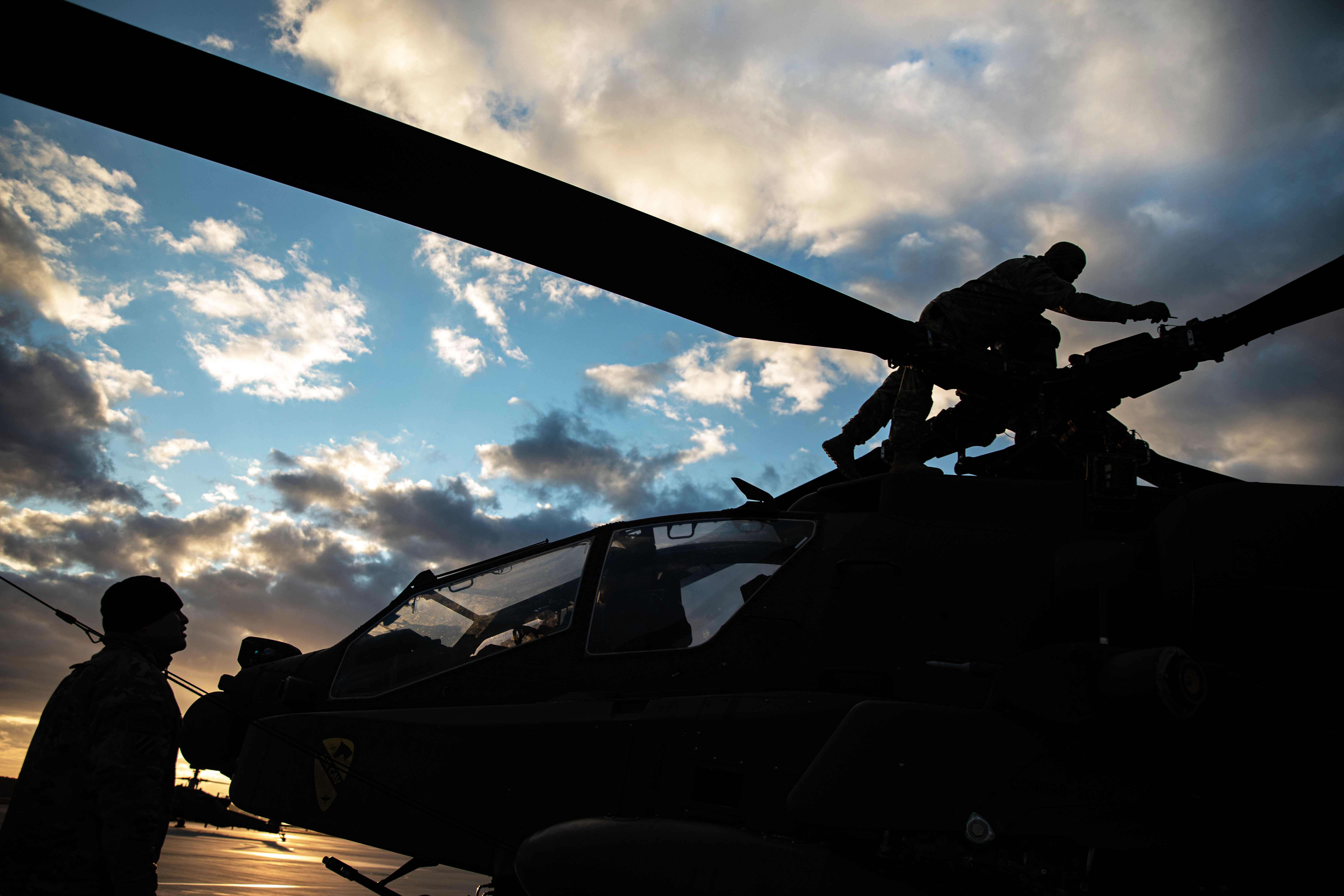


By Kevin Baron, Marcus Weisgerber, Caitlin M. Kenney, Bradley Peniston, and Tara Copp
Introduction by Kevin Baron
“Despotism violates the moral frontier just as invasion violates the geographical frontier,” Victor Hugo wrote 160 years ago. In February, Russia’s Vladimir Putin violated both by launching a full-scale attack on independent Ukraine, just beyond the borders of the NATO alliance. In doing so, Russia has forced the U.S. military to reconsider its own plans for the world, and how to best defend the moral and physical boundaries of democracy and the liberal world order.
But how much will Russia’s war change the Pentagon’s immediate plans? When Defense One reporters began conducting interviews for this year’s State of Defense special report, Putin was still amassing forces outside of Ukraine. At the time, White House and Pentagon officials still had not released their expected new strategies for national security and the military, documents which are meant to guide decisions on the defense budget, weapons, personnel and where to position them around the world. U.S. military planners were laser-focused on the Pacific, rethinking the roles their service branches would play in a new threat matrix that for the first time since September 2001 did not include Afghanistan as an existential concern but more than ever included space and cyber threats.
One month later, the world has been rattled by Putin’s war in Europe, his brutality toward Ukrainian civilians, his barely-veiled nuclear threats, and his cozying up to China. Pentagon planners say they’re watching Russia’s immediate moves, but forging ahead with long-term plans for the geopolitical competition between the United States and China. It’s hard to know how long they can do so, or whether NATO can keep its powder dry for long.
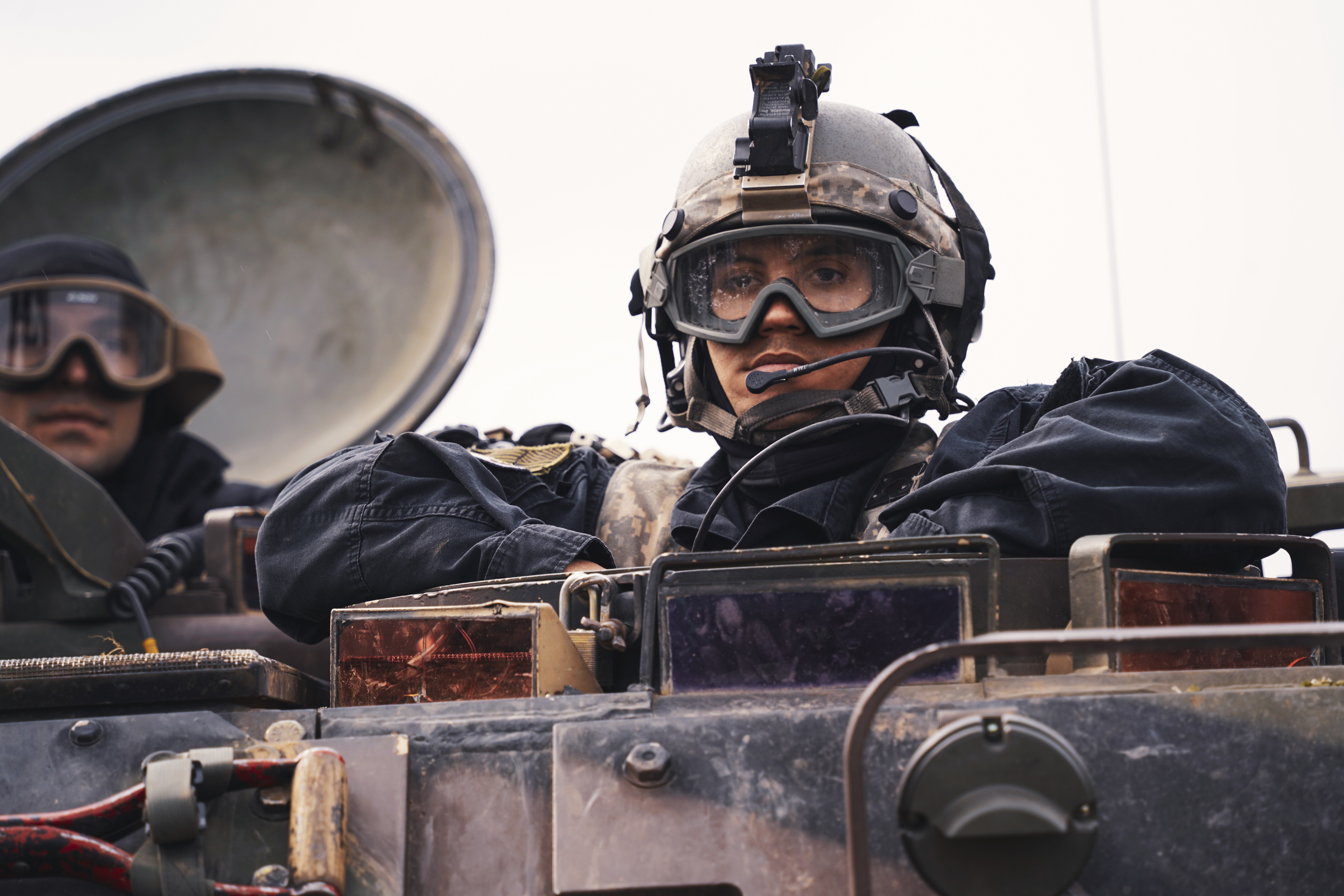
Army / Sgt. LaShic Patterson
Each service branch already was in the middle of doing what they always do: reconsidering what they need to change to meet changing threats. How much any of them will be forced to change what weapons they need, where they position their people, or how much they need to spend, is now largely in the hands of a madman in Moscow.
In 2021, Army leaders were planning for (yet another) pivot to the Pacific. The end of the Afghanistan war was a bigger symbolic shift than an actual change of Army resources, but it had strategists questioning what came next. Army Secretary Christine Wormuth spoke exclusively to Defense One about her goals for modernizing things like weapons, personnel and computer networks, while other critics worry far more soldiers are needed in Europe now, rather than staring at China.
For the Air Force, on one hand, preparing for China is not that much different than preparing for Russia, officials say. On the other hand, watching the Ukraine conflict from the skies and deterring Russia at NATO’s border has exposed the U.S. reliance on decades-old aircraft to do basic intelligence missions alongside its high-end stealth fighters. Already, the Air Force’s entire suite of aircraft was under reconsideration, as leaders determine what they need, and how much they hope Congress will give them to spend.
“Now, Air Force leaders are figuring out how they would use, and base, all of those new aircraft if the U.S. had to fight China or Russia. And that could mean shedding missions or figuring out new ways to fight,” reports Defense One, including an exclusive interview with Chief of Staff Gen. C.Q. Brown. It also means hoping for a budget to do it all and more, with increased demand for ISR drones and new worries that America’s nuclear weapons-delivery vehicles suffice.
A few miles even higher, Russia’s war is testing the Space Force, and helping its advocates make the argument that the newest service branch needs to expand its capabilities far faster than planned. After all, space is “the most important foundational area for everything we are doing, everything we need to be doing,” said the Pentagon’s comptroller, last month. Defense One spoke to chief of space operations Gen. John Raymond, who tells more here.
No service was already pitching a major expansion like the Navy when China was the main concern. Now, Russia’s war on Europe and threats at the West may have provided all the reason Congress needs to help Chief of Naval Operations Adm. Mike Gilday steam closer to his vision of building a 500-ship fleet. It’ll take more than just money, but the real questions are: will the Biden administration let the Navy do it, and how soon? Gilday outlines the details of his vision, and how he hopes to navigate the roadblocks that could slow the massive shipbuilding expansion, here.
Meanwhile, the clock ticks toward 2030 for the Marine Corps’ big plans to reinvent itself. In the meantime, Commandant Gen. David Berger describes to Defense One how the service is moving beyond plans and into fielding new equipment and testing new concepts and formations. The devil may be in the details of changes like new battalion structures and a stronger emphasis on diversity. Berger spoke just before Putin’s invasion and like his joint service counterparts insisted at the time it would not change much, saying that the Marines would continue to devote three-quarters of its force to the Indo-Pacific region. “China is the nation's most significant challenge.”
Whatever the outcome for Putin or Ukraine, predicting the year–and the decade–ahead just got a bit more complicated.
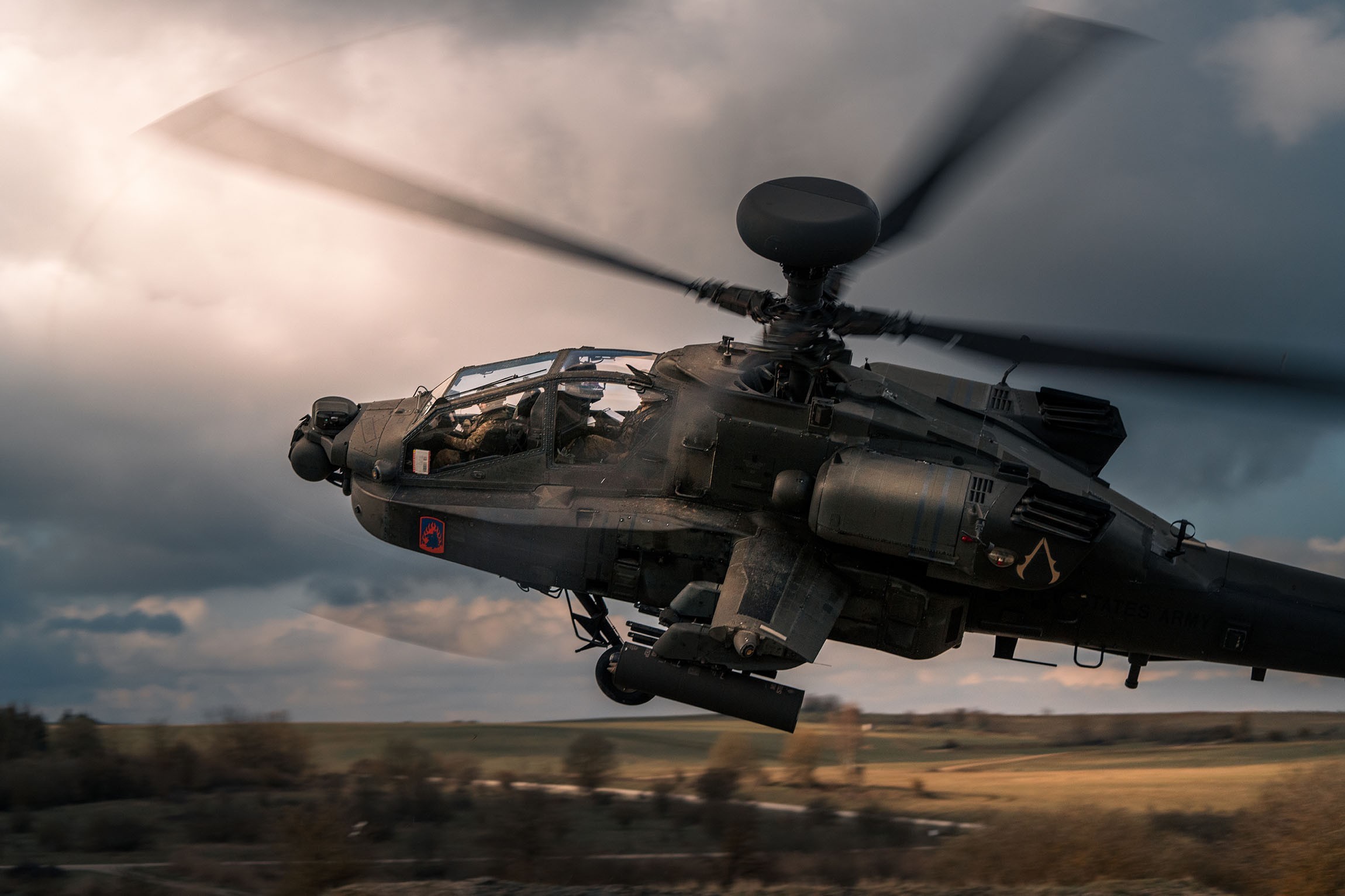

Time for modernizing…but for What? Where? And Why?

By Caitlin M. Kenney
What’s a soldier to do when the future fight looks like it will be led by space guardians, sailors, Marines, and airmen? The Army’s 20-year mission in land-locked Afghanistan is over, minimized in the Middle East, and the national security establishment’s focus on China has the ground service scrambling to develop capabilities to contribute to a joint war in the Indo-Pacific region.
Then war came back to Europe. The Army’s deployments in response to Moscow’s military buildup around and attack on Ukraine showcase its ability to get forces into Europe quickly. But what the 100,000 U.S. soldiers currently in Europe will do, how long they’ll stay, in what numbers, and with what mission all remains undefined as Biden administration and NATO leaders manage the West’s military’s response to the war.
Scholars and U.S. officials already are debating whether the U.S. Army should reposition its soldiers worldwide. Still, Russia is considered the runner-up to China’s longer-term power ambitions, which the Army is preparing to compete against.
That is, in my view, a very foundational set of capabilities, because almost all the other modernization areas–integrated air and missile defense, long-range precision fires–you know, have to have a network to be able to be usable.Army Secretary Christine Wormuth
In February, Army Secretary Christine Wormuth listed six service objectives in a message to the force, half concerning modernization and readiness and the other half, personnel. In an interview, Wormuth said the objectives should guide the Army for the next few years.
“We are keeping the three big priorities of people, modernization, and readiness, but you know those are our big, broad priorities. And I felt like after about six months [as secretary], it would be helpful to try to be a little more specific, sort of on that foundation, in terms of what were the kinds of things that I think it's important for the Army to focus on trying to make progress towards in the next few years.” she said.
Modernization
The Army has six modernization priorities, including next-generation combat vehicles, computer networks, and vertical-lift aircraft. The network element might not be the flashiest, but it is probably the most important underlining to all the other priorities, especially when they must operate in contested environments.
“That is, in my view, a very foundational set of capabilities, because almost all the other modernization areas–integrated air and missile defense, long-range precision fires–you know, have to have a network to be able to be usable,” Wormuth said.
This data-centric Army is being tested in their annual Project Convergence event, which experiments with connecting a range of military technologies and learning how to share data across different systems. Last year they featured 110 technologies and invited close allies to observe, including the United Kingdom and Australia. This year the Army wants these allies to participate and increased participation from the other U.S. military services, Wormuth said.
The equipment that soldiers will get their hands on in 2022 include the Integrated Air and Missile Defense gear, the prototype of the Directed Energy-Maneuver Short-Range Air Defense laser, the Lower Tier Air and Missile Defense Sensor prototype, the Next Generation Squad Weapon and its fire control component, and the Robotic Combat Vehicle prototype.
The Army’s long-range hypersonic missile prototype is expected to arrive in 2023; the first artillery unit to get it is already developing the tactics, techniques, and procedures to use the equipment at Joint Base Lewis-McChord in Washington state.
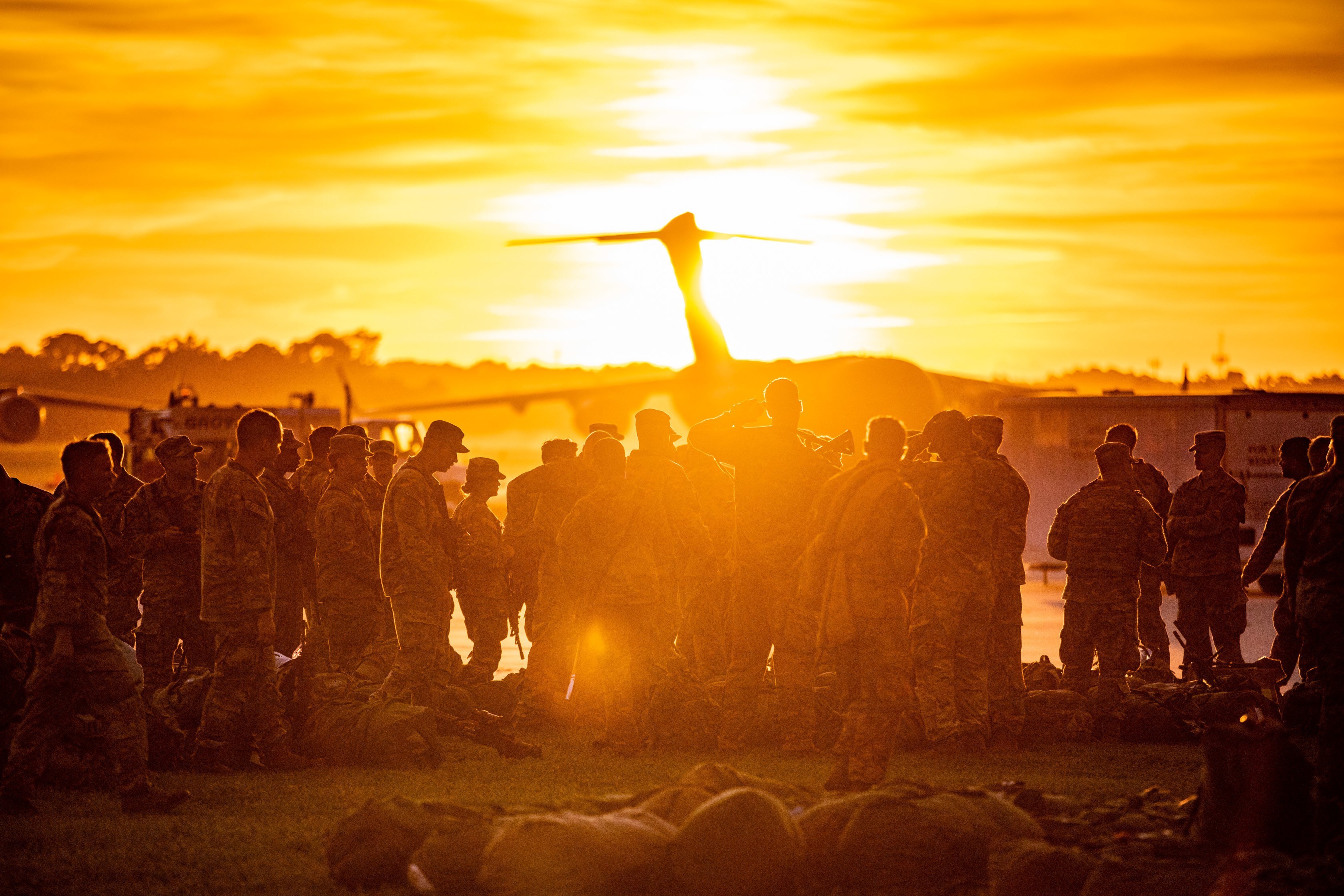
Army / Pfc. Vincent Levelev
The first two Army units with combined artillery, cyber, intelligence, and electronic warfare elements, called Multi-Domain Task Forces, stood up in the past year: one at Lewis-McChord to focus on Pacific operations and a second in Germany to work with U.S. European Command and Africa Command. Wormuth said the task forces are figuring out how they will operate, including the command and control of their artillery units.
This year, the Lewis-McChord task force will participate in more joint exercises in the Pacific, working with other services and commands on best practices for sharing information and joint targeting, she said.
European Deployments/ Indo-Pacific Focus
Wormuth said in February that the Army and Pentagon must remain disciplined and focused on building a force that will be able to compete with China’s in the 2030s, even as it sent thousands of troops to Europe to respond to Russian aggression. That was before Putin’s full-scale invasion of Ukraine, however she conceded at the time that some of the Army’s plans for 2022 may need adjusting.
This year, for example, the Army is expecting to implement a new method of training and equipping its units for the regions to which they could deploy: the Regionally Aligned Readiness and Modernization Model, or ReARMM. Wormuth is keeping an eye on whether the Ukraine-related deployments will complicate these scheduled cycles.
“Real-world deployments can definitely throw a wrench into that, in terms of if there's a unit that was supposed to be going into the modernization window to, say, get the new long-range hypersonic weapon, but they're over in Europe—you know that's a challenge for us,” she said. “So, if these deployments in Europe wind up stretching out, shall we say, I think we are going to have some homework to sort of look at that.”
Wormuth said the Army must be able to “walk and chew gum,” meaning, keep an eye on the Indo-Pacific region while responding to crises elsewhere. The “warfighting tasks” that soldiers do are relevant in both theaters, though long-range hypersonic fires, for example, are more likely to be useful across the greater distances in the Pacific than in Europe, she said.
If a conflict were to happen in the Indo-Pacific theater, Wormuth has said the Army would have five “core tasks” and act as a “linchpin service” for the joint force. This year, the service will look at what capabilities they would contribute in such a conflict, such as setting up command-and-control units, as well as sustainment. Their Pacific-focused multi-domain task force and the 5th Security Force Assistance Brigade would also be part of those capabilities.
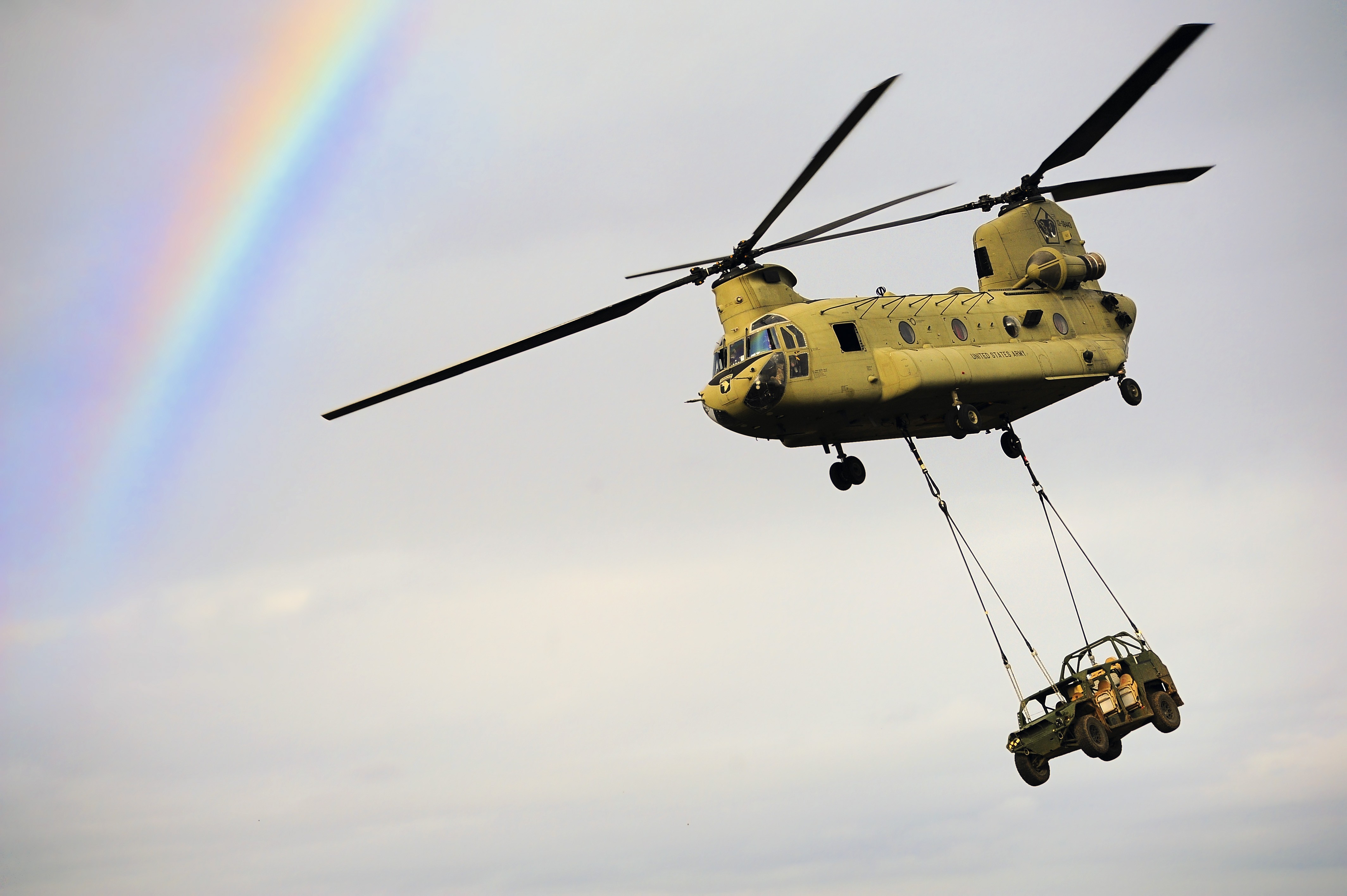
Army / Elena Baladelli
In this and next year, Gen. Charles Flynn, U.S. Army Pacific commander, is working towards having soldiers be in the region longer with a bigger presence in a given year, Wormuth said, but did not clarify by how much. Part of this involves soldiers operating in the first island chain this year as part of the Pacific Pathways exercise series, she said.
“Providing a persistent presence forward in the region is part of that posture equation. We do have to have those forces forward; we have to be there to understand the environment and the conditions that we're operating in. We have to be able to provide scalable command and control. We have to be able to provide planning, synchronization and coordination for Army capabilities, but for and on behalf of, the Joint Force,” Flynn said at October’s AUSA conference.
Budget
Budget woes loom for the Army, and not just because they are racing to buy new gear. Congress was over five months late on passing an appropriations bill for the current fiscal year, forcing the Army to operate in the meantime with last year’s funding level amid historic inflation levels and a tight timeline to get new programs and projects off the ground. The omnibus spending bill that Congress passed March 10 included reimbursement for the unanticipated European deployments related to the Ukraine conflict.
The fiscal 2023 budget proposal is also late from the White House, giving the Army even less time this year to figure out what it will be able to afford by Oct. 1.
“I think the Army budget is probably going to stay relatively flat in the next few years. So we have to think about how are we going to maintain our momentum on the modernization agenda, but also making sure that we're maintaining readiness,” Wormuth said.
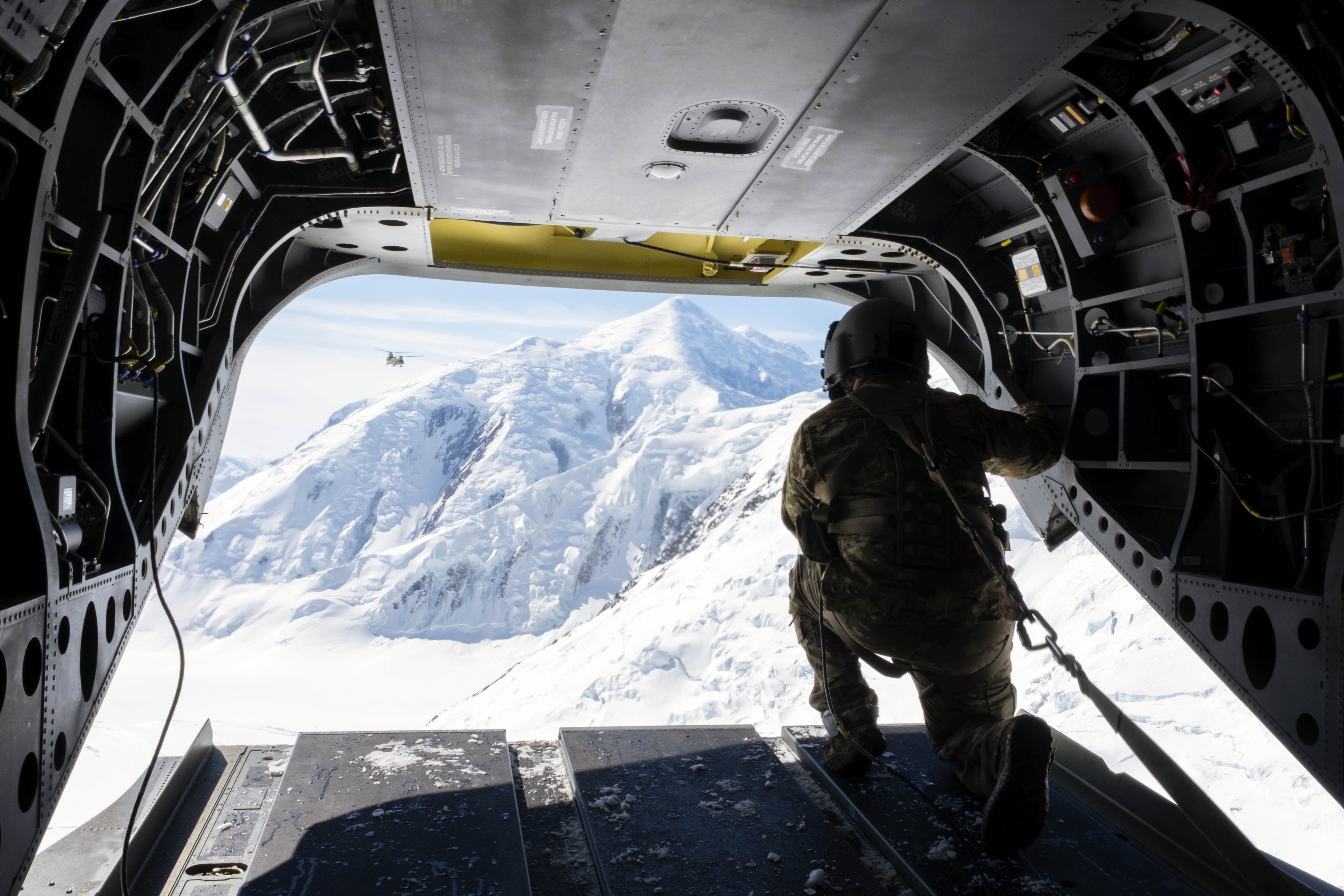
Army / Benjamin Wilson
Budget discipline will be key. Army leaders have worked hard to restore their readiness to fight after years of sequestration and budget restrictions, Wormuth said, and they have to find ways to maintain it while also caring for soldiers, their families, and infrastructure.
People
Three of Wormuth’s priorities directly concern soldier life: building positive command climates, reducing “harmful behaviors” like sexual assault and suicide, and improving recruiting and retention.
Along with the other services, the Army will create a special trial counsel office for 11 crimes including sexual assault, murder, stalking, and domestic violence. Congress established this new prosecutorial organization in the FY 2022 National Defense Authorization Act. Wormuth has already approved the service’s implementation plan to establish it.
“To ensure independent decision-making and increase victim trust in the new system, the officer in charge of the [Office of Special Trial Counsel] will report directly to the secretary,” Lt. Col. Randee Farrell, a spokeswoman for the Army secretary, said in a statement.
Army officials also plan to improve access to mental health services and increase the number of available behavioral health workers, especially in austere communities like Alaska, Wormuth said. In 2021, 11 soldiers died by suicide in Alaska, up from seven the year before. U.S. Army Alaska commander Maj. Gen Brian Eifler is mandating wellness checks for every soldier. Data will be collected on Eifler’s mandate to see whether the Army can scale it up, she said.
Building trust between leaders and their troops is at the heart of the Wormuth’s personnel initiatives and involves establishing a positive workplace and being accessible to have “hard conversations” about topics like suicide and sexual assault. Making the time to have these conversations is as important as a day on the range to practice marksmanship, she said.
“So, I think the thing that the chief and I have to do is to help our leaders prioritize what we're asking them to do and to make sure that we're giving them the time to be able to do those kinds of things,” she said. “Gen. [James] McConville felt really strongly about making people one of our three priorities. And I think a big part of that was to signal to the Army this is something valuable and you should spend time on it.”
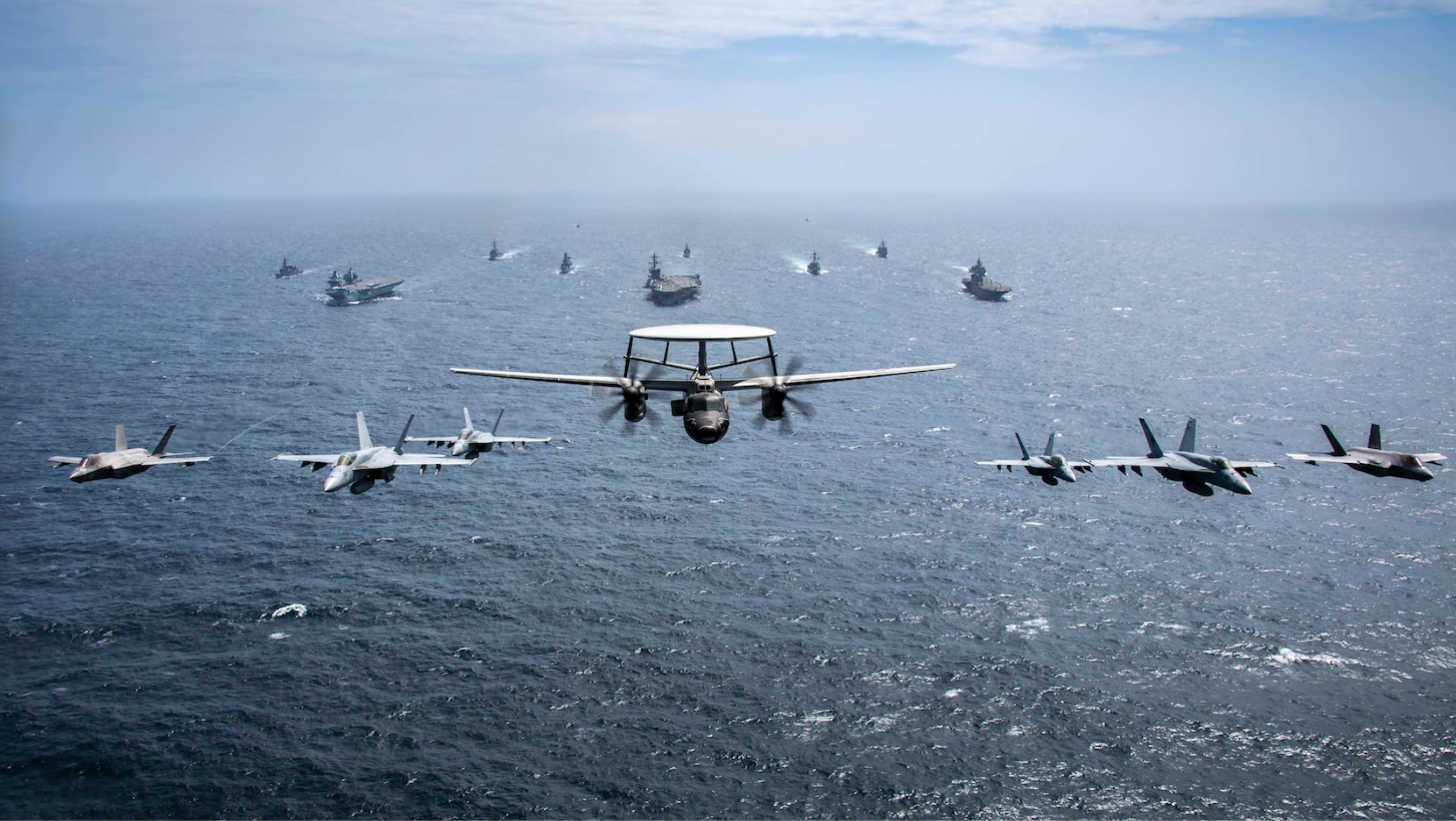

The fleet’s attempts to focus on China have once again been interrupted by the resurgence of an old foe.

By Bradley Peniston
China, China, Chi—what’s that you say? Russia’s back?
Since December, the U.S. Navy’s highest-profile operation has been far from the Pacific waters that harbor the Pentagon’s self-declared “pacing challenge.” Instead, the spotlight is on the aircraft carrier Harry S. Truman, which has been flinging jets aloft in the eastern Mediterranean, sending them as far north as the Baltics to deter Russia from advancing into NATO territory.
But the Truman strike group is hardly the only flotilla working to send a message in the Med. A week after Vladimir Putin sent tanks rolling into Ukraine, more than a dozen Russian warships and submarines gathered for an unusual seagoing photo-op under the protective umbrella of friendly warplanes and anti-ship missiles based in Syria. Analysts have warned about Russian efforts to build naval power inside the Sixth Fleet’s area of operations; the February photo-op reflects Moscow's decision to show off its prowess.
As fate would have it, Russia launched its invasion just after the Navy’s 2023 budget proposal would have gone to Congress in a normal year. Instead, the Biden administration’s spending plan has yet to arrive. Will it contain hasty revisions to feature Russia a bit more prominently? With bombs and shells falling around Ukraine, Congress can be expected to have some pointed questions.
First, let’s go back to a simpler time—a few weeks ago—when Navy leaders were largely concerned with expanding the fleet by 200 or so crewed and uncrewed vessels to keep up with China’s advancing weapons and prodigious shipbuilding, while convincing dubious lawmakers to fund this massive expansion, in part through the never-popular expedient of retiring a bunch of fairly old and fairly new warships.
Several years of analysis combined with some groundbreaking exercises and experiments have convinced Chief of Naval Operations Adm. Mike Gilday that the Navy will need to add more than 200 vessels to its current fleet of 298 battle force ships to successfully face off against China in the next decade.
“Based on that, based on the Large Scale Exercise we did over the summer, based on the integrated battle problem we just did in 5th Fleet with some 100 unmanned platforms over the past few weeks, I’ve concluded, consistent with the analysis, that we need a naval force of over 500 ships,” Gilday told an audience at the WEST 2022 conference in February.
This work is expected to produce a long-term shipbuilding plan that will be the Navy’s fourth in recent years. It will follow the 2016 declaration that the Navy should build up to 355 ships; 2019’s integrated naval force structure assessment; 2020's Battle Force 2045, completed under then-Defense Secretary Mark Esper; and the Biden administration’s first long-range shipbuilding document, released last June.
Gilday has said that the new plan will most closely hew to the Battle Force 2045 document—“it’s the one that I’ve based my best advice on”—because it was led by the Office of the Secretary of Defense, not just the Navy and Marine Corps.
“I think that kind of naval force, that kind of distributed force, is consistent with the analysis we see from the Joint Staff and [the Office of the Secretary of Defense] with the Joint Warfighting Concept,” he said. “I think it speaks to the vulnerabilities we hear called out by the Joint Staff and the Chairman’s risk assessment.”
Overall, Gilday said, “We’re doing a lot of work to look at things differently, thinking about how we would fight differently, in distributed fashion across a wide vast ocean like the Pacific, in terms of integrating all domains simultaneously.”
The CNO ran down a list of ship types and the numbers to expect in the long-range plan.
“My view on carrier aviation remains unchanged: I think we need 12 carriers,” he said. “I think we need a strong amphibious force, to include probably nine big-deck amphibs and another 19 or 20 [smaller amphibious warships] to support them.”
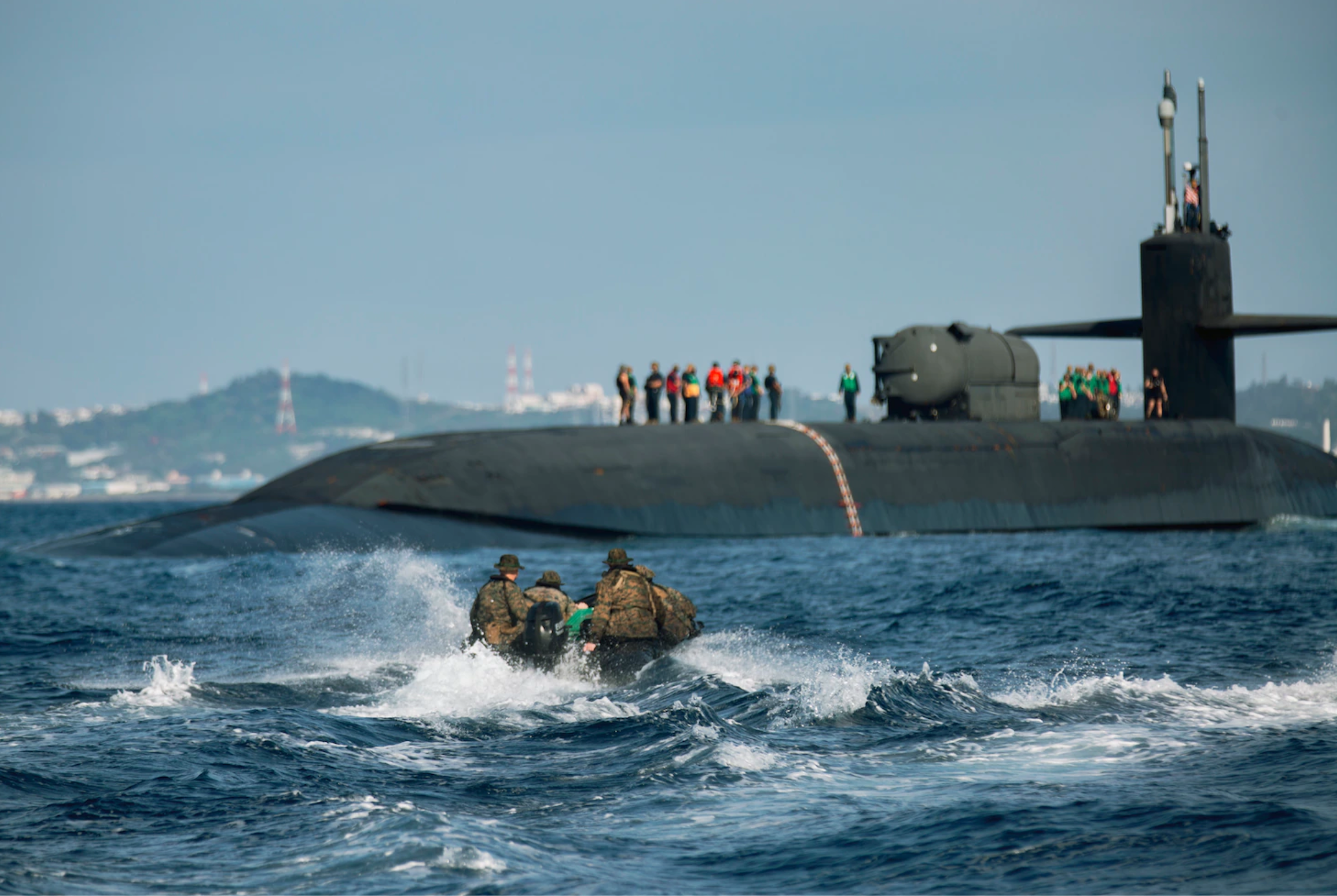
Navy / Sgt. Destiny Dempsey
“Sixty destroyers and probably 50 frigates. Seventy attack submarines and a dozen ballistic missile submarines. About 100 support ships. And probably, looking into the future, 150 unmanned” vessels, he said.
Gilday also said the Navy has continued to drive down the number of ship-days lost to unexpected delays in shipyard work, a focus of his since he ascended to the Navy’s top job in 2019. He added that more than half of those days were consumed by the few remaining Ticonderoga-class cruisers, ships that he has sought Congressional permission to retire. He said the Navy entered this year’s budget negotiations asking to retire all seven Ticos, but the 2022 defense authorization act requires the service to keep two of them.
“I wish the number was zero,” he said.
A similar battle is looming with a far younger class of ships: in its 2023 budget request, the Navy will reportedly ask lawmakers to allow it to retire up to 10 Freedom-class littoral combat ships, vessels that have struggled to find their place in the fleet when they haven’t been struggling to get underway.
If Congress didn’t buy the Navy’s reasoning on the cruisers, what are the chances that lawmakers will be happy with the upcoming 2023 budget request? Gilday told reporters last month that he thinks he’s made progress in repairing strands of trust eroded by the unexpectedly lengthy and costly efforts to develop and deploy the Ford-class aircraft carriers, DDG-1000 destroyers, and the two LCS classes.
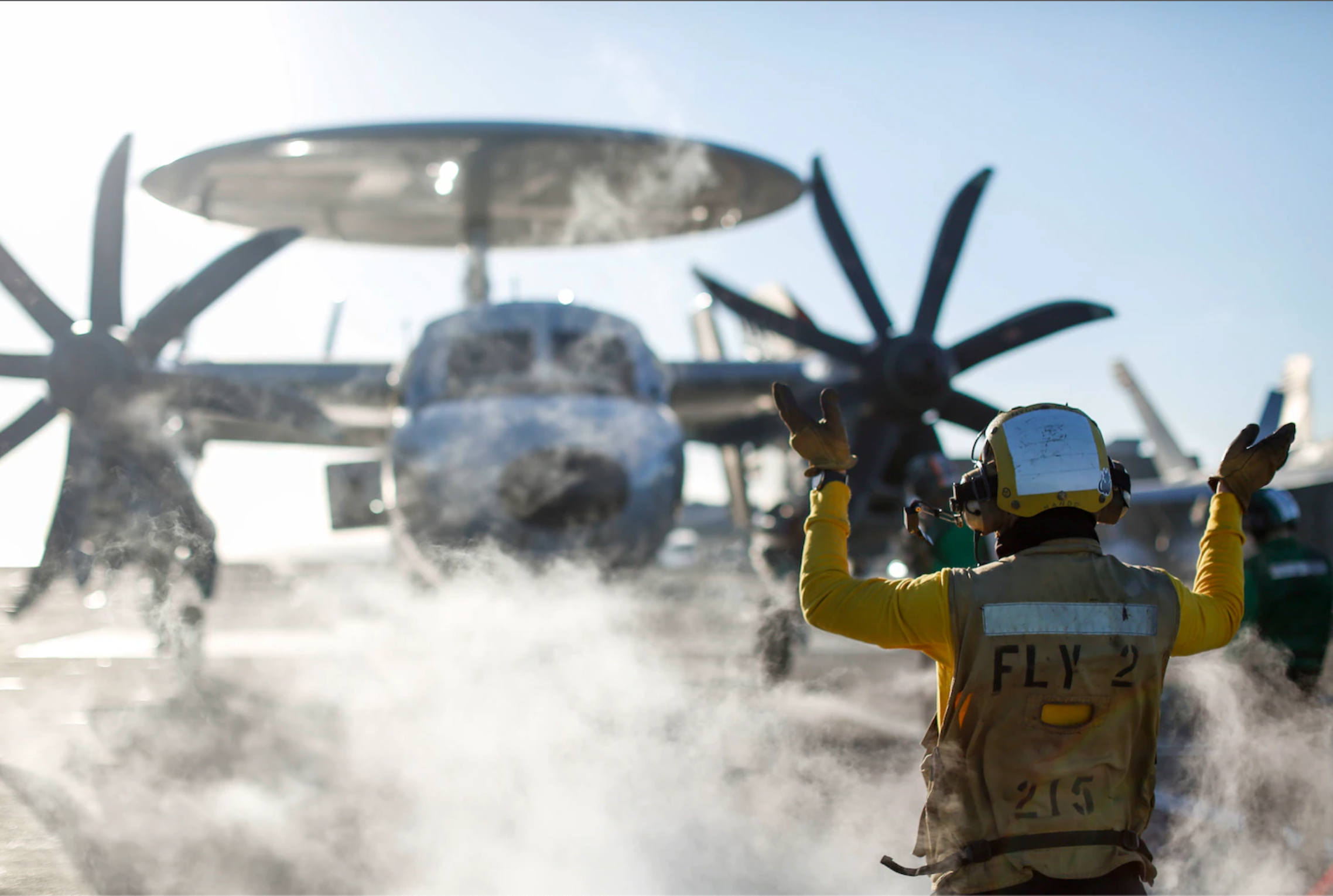
Navy / MC3 Michael Singley
We’re doing a lot of work to look at things differently, thinking about how we would fight differently, in distributed fashion across a wide vast ocean like the Pacific, in terms of integrating all domains simultaneously.Chief of Naval Operations Adm. Mike Gilday
The CNO said he has taken lawmakers’ concerns to heart, and that’s why the service’s unmanned programs are now moving in “an evolutionary manner, not a revolutionary manner.”
Gilday also suggested that he and the Navy have had some success in persuading Congress that the service is on the right track, and in explaining the value of a navy to the American public.
This year, Gilday will have a confirmed Navy secretary to help him make the service’s case in the upcoming hearings into the 2023 budget proposal. It took the Biden administration nearly seven months to appoint and confirm Carlos Del Toro, a retired Navy commander.
But at least one key lawmaker has signaled his reservations.
“I continue to be concerned as to how CNO Gilday’s plan aligns with the Biden Administration’s forthcoming National Defense Strategy,” said Rep. Rob Wittman, who represents Virginia’s tidewater region and is the top Republican on the House Armed Services Subcommittee on Seapower and Projection Forces, in a March 2 statement.
“Last year, this administration did not even provide Congress with a 5-year investment vision. Without a credible 30-year shipbuilding plan, the industrial base has no real map to invest for the future. Additionally, the ‘divest to invest’ approach of this administration presumes a benign China response in the short term. We need to be ready for conflict in 5 years, not in some fairy tale Battle Force 2045. The administration needs to be forthright with Congress in the fiscal year 2023 budget request and their intent to dissuade future conflict now.”
And even if China stays “benign,” there is still Russia to deal with. Stay tuned.
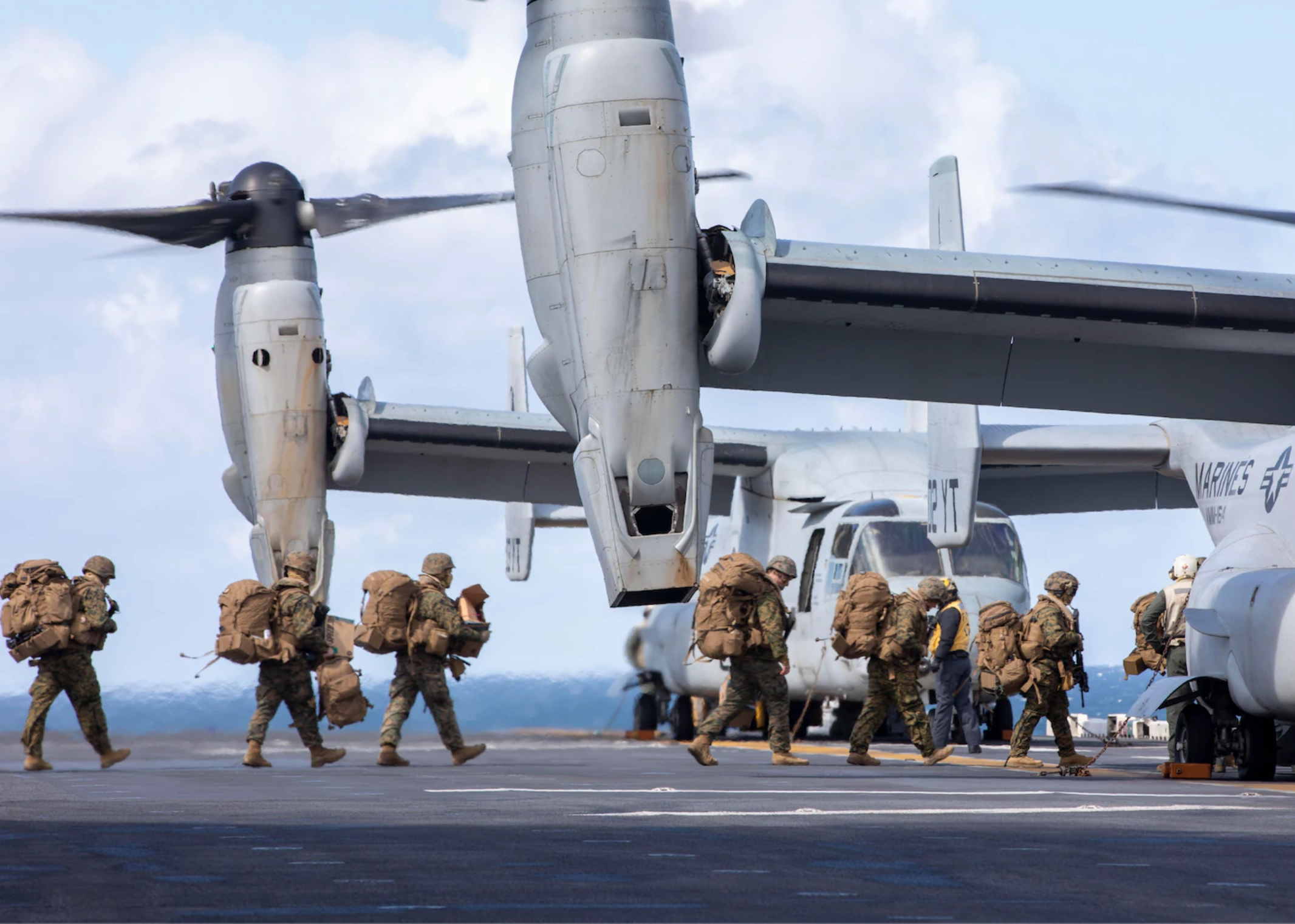
Navy / MC2 Michael J. Lieberknecht


Whether it’s China or Russia in the news, leaders are keeping their focus on making near-term decisions about its long-term future.

By Marcus Weisgerber
The U.S. Air Force turns 75 this year, but it's the most relevant it's been in decades. While ground forces contributed the lion’s share to the two decades of counterinsurgency wars in Afghanistan and Iraq, the Air Force shaping itself to deter the wars of the future.
“The pacing challenge…is China, but obviously, Russia is of great concern also,” Air Force Sec. Frank Kendall said in an interview just days before Russia invaded Ukraine. “As we've had for quite a few years, we have to have balance in the capabilities of the department and we have to deal with global responsibilities.”
That invasion doesn’t change much about how the Air Force sees its future, largely because the weapons it's buying to deter China are the same it would need for Russia. In recent years, top Pentagon officials have said the long-term focus is China’s military rise, but Russia was always a close second.
“We gotta be able to look and think about both of them,” Gen. Charles “CQ” Brown, the Air Force chief of staff said in a separate interview, again days before the Russian invasion. “What we can't do is just go: ‘it's all about one and [not] the other.
“You don't want to think about just the short term at the expense of the long term,” Brown continued. “We gotta be able to balance our abilities and capabilities, to be able to address the current events, whether it's Russia, whether it's in the Middle East, at the same time, we continue to modernize and transition to the future.”
The age of the Air Force’s fleet has been noticeable in its response to Putin’s war in Ukraine. In an attempt to fortify NATO’s eastern flank, the Air Force has deployed Rivet Joint signals intelligence planes built in the 1960s and JSTARS radar aircraft that began flying missions more than three decades ago. Every day, KC-135 refueling tankers built in the 1960s and KC-10 tankers dating back to the 1970s are high above Poland and Romania while NATO allies France, the Netherlands, and the UK all use newer tankers built in this century.
But newer replacements are on their way. F-35 and F-15 fighters, KC-46 tankers, and new search-and-rescue helicopters are all entering the fleet. The B-21 stealth bomber is progressing toward its first flight. And new warplane technology, part of the Next Generation Air Dominance effort, is secretly under development.
Now, Air Force leaders are figuring out how they would use, and base, all of those new aircraft if the U.S. had to fight China or Russia. And that could mean shedding missions or figuring out new ways to fight.
“I do think we need to think about the degree to which we support different requirements,” Kendall said. “Those requirements are not going to go away, but I think we do need to think about how we balance our posture around the world, and how we balance both near-term and longer-term capabilities.”
Over the past two decades, the Air Force has picked up new missions, the largest among them: operating a fleet of high-flying, reconnaissance and strike drones. Kendall has previously talked about new types of drones. The service’s 2023 budget proposal is expected to reflect some of those changes, he said.
“The Air Force has to support a combination of long-range strike capabilities and forward tactical air capabilities, as well as mobility capabilities, and our strategic [nuclear] capability,” he said. “None of those missions go away…and as the threats get more severe, then you want to have more capability.”
Brown said the Air Force must figure out which of today’s weapons will cease to be relevant in the decades ahead.
“When I think about…making that transition to the future, it's how we balance risk between the demand signals from the combatant commanders today, to the demand signals that the combatant commanders will have five, 10, 15 years from now,” he said. “If we maintain the same demand signal with the same capabilities, we'll never transition to the future...“We gotta be able to balance that as we go forward.”
Kendall also pointed to the two-year-old Space Force and its growing number of missions. At the end of the day, the Air Force will be competing against its younger sibling for money in the Pentagon budget.
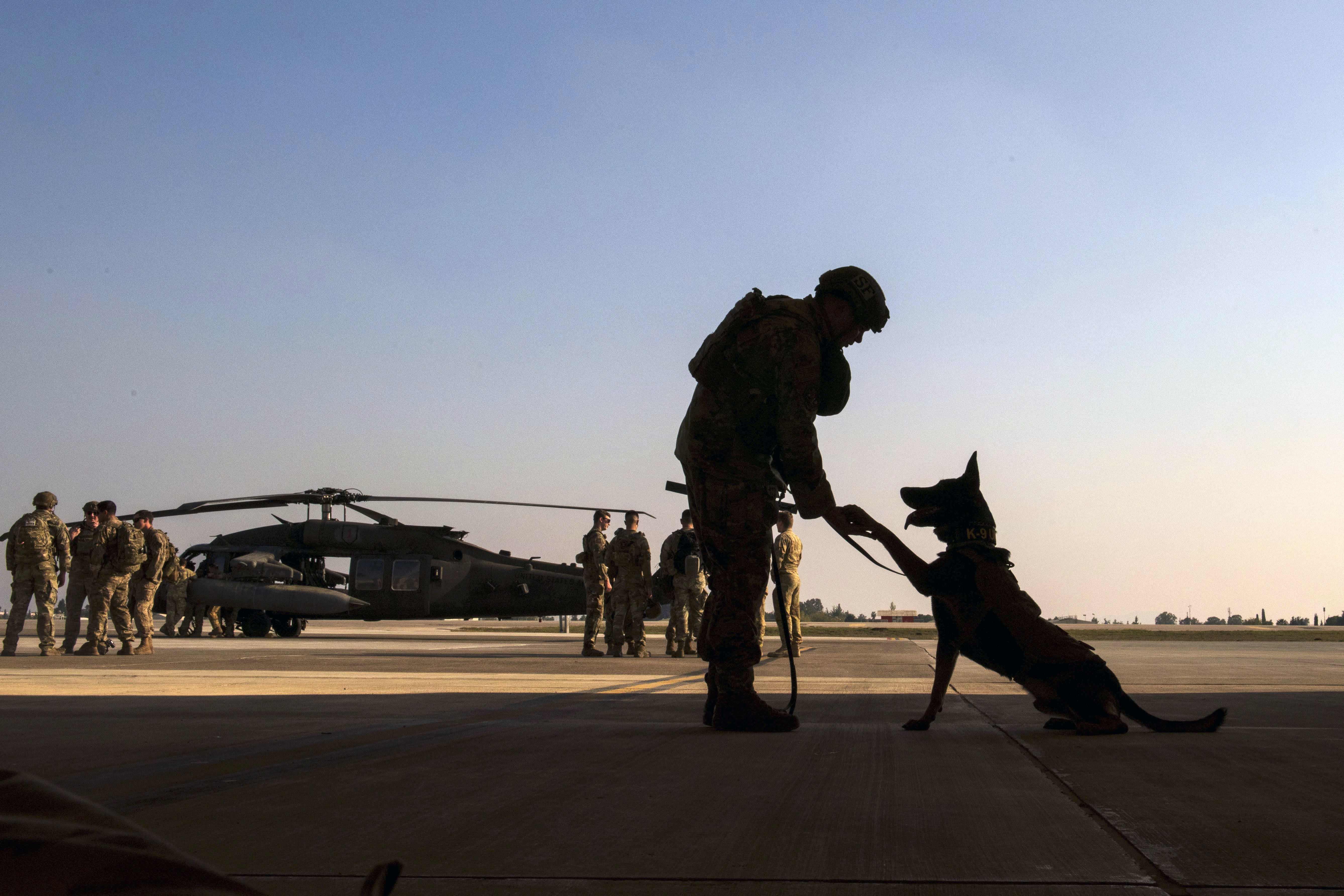
Air Force / Senior Airman Brandt Self
That budget is expected to grow this year and again next year, but some is inflation, which is driving up the costs. When budgets were tighter earlier in the 2010s during Kendall’s last tour as the head of Pentagon acquisition, the Air Force found itself shedding people to pay for new planes.
“I'm hopeful that we can stay pretty close to the force structure we have as we modernize,” Kendall said. “It's a question of resources.”
Space Force leaders are still figuring out the satellite constellations needed to counter China and Russia.
“I can see the requirements increasing over time and the demands for money increasing over time to some degree,” Kendall said. “One way to resource that is to take the force structure down temporarily and then build it back up.”
But both Kendall and Brown want to avoid that.
“I've been around the Air Force when we had a push to reduce our end strength in order to get force structure. It didn't work out so well,” the chief of staff said.
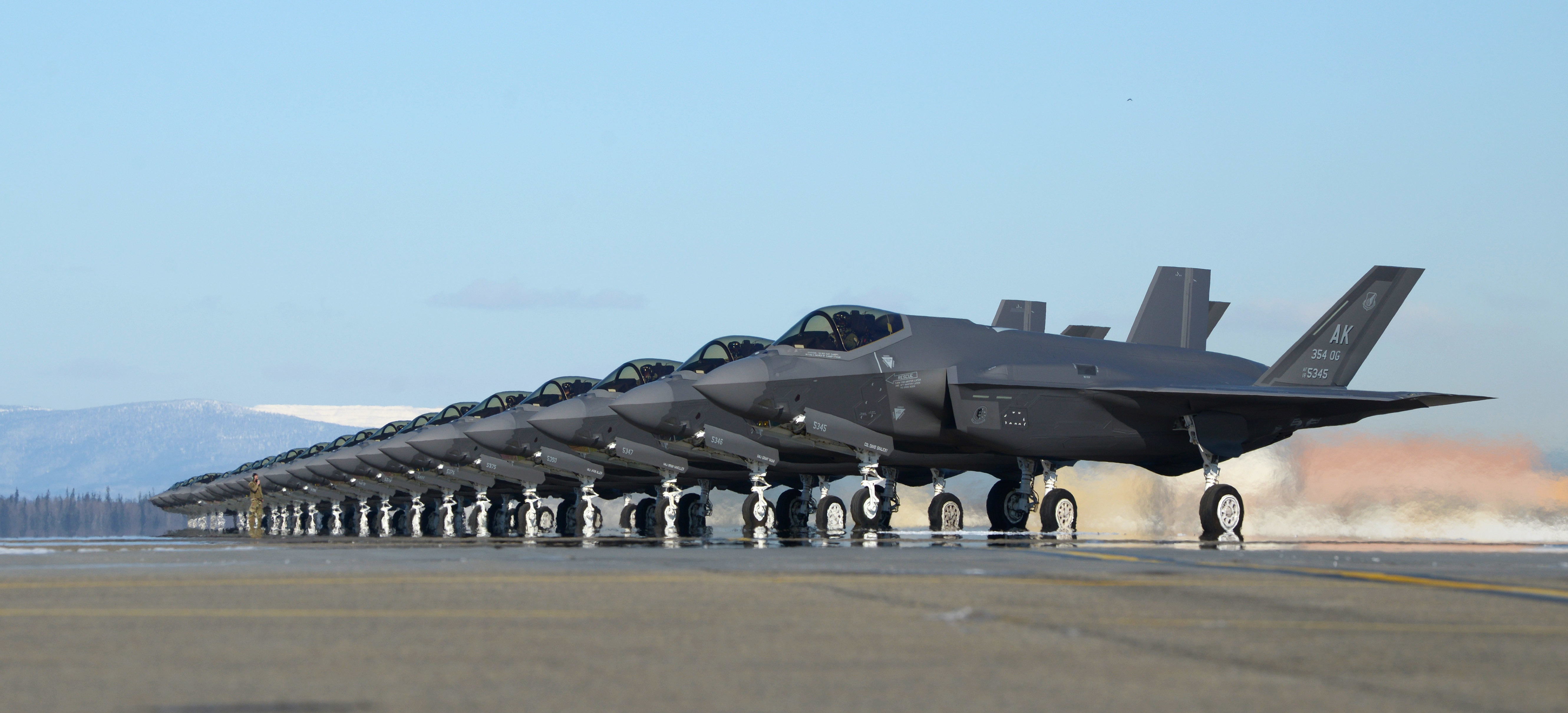
Air Force / Senior Airman Beaux Hebert
Creating uncertainty
When Kendall thinks about the future, his prime focus is creating uncertainty for China, Russia, or any other potential adversary. One way is by spreading out forces across more than a handful of existing bases in the Indo-Pacific.
“For the Air Force to do that, we have to find places where we can land and take off,” he said. “That limits us a little bit, but we also need support infrastructure there.”
For some bases, that means building new hangars and facilities to withstand a missile attack. It also means using decoys.
During the Cold War, the Air Force had plans to take off and land along straight stretches of the German autobahns. While that might still work in Europe, it’s not necessarily an option in the Pacific.
If troops are more spread out, an enemy always needs to figure out a way to counter that. That could mean an enemy wasting its missiles on bases that are empty.
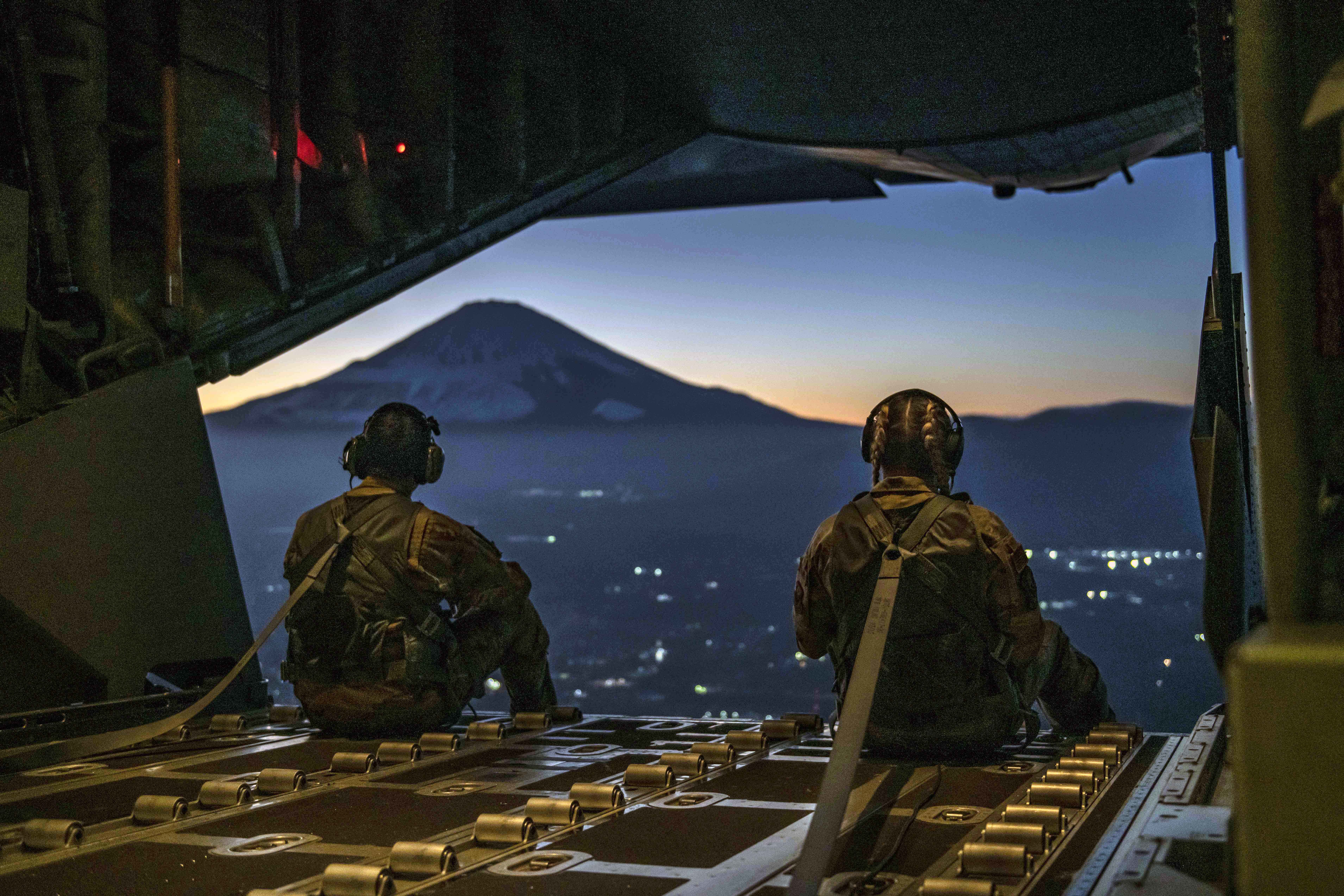
Air Force / Senior Airman Jessi Monte
“We need to create uncertainty and really just make it harder for him and increase the [weapon] inventory size he needs,” Kendall said. “As a deterrent matter, if he's uncertain about the outcome of that strike, and how much of an Air Force he's still gonna have to contend with after he does it, that's a good thing for us.”
The Air Force is also coming up with new ways to quickly deploy troops to remote locations—a capability it calls agile combat deployments. Once deployed, airmen would do jobs in addition to their specialty, allowing fewer people to deploy,
“The real goal here is to be able to take small packages of airmen, generate combat airpower from just about any location they can support,” Brown said. “If our adversary sees us operating from as many airfields as we can throughout the Indo-Pacific, they've got to account for [it].”
This is a big change from the past two decades, when the Air Force operated largely from super-bases with established infrastructure in the Middle East and Afghanistan.
“If we go to a major conflict, there better not be any union cards,” Brown said. “We're gonna have to be able to take our airmen and be able to flex back and forth.”
When Brown thinks about battles of the future, he envisions a far more dangerous aerial environment than Afghanistand and Iraq, where Air Force fighters and bombers flew without worrying about enemy aircraft or surface-to-air missiles.
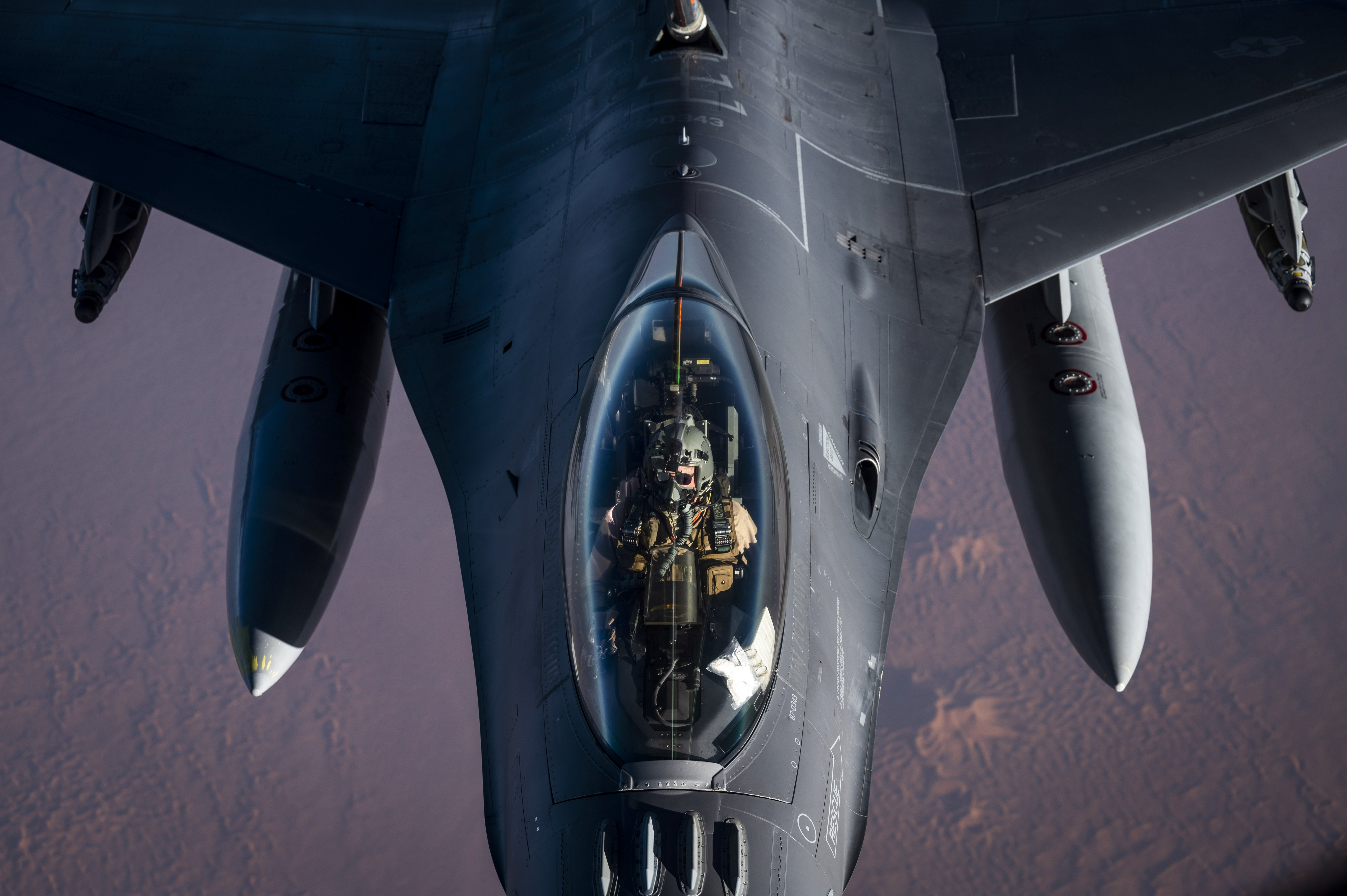
Air Force / Staff Sgt. Joseph Pick
“That may not be the case in a future conflict,” he said. “We've got to make the transition to those capabilities that will be survivable in a highly contested environment.”
For Kendall, that means investing in new technologies and weapons that have a value in those types of conflicts. He said the Air Force needs to figure out earlier in a weapon’s development how much of priority it is and if it’ll have the cash to buy it down the road.
“If you know you're not going to have it high enough on the priority list to fund, that it's not going to be affordable, and it doesn't have enough value relative the other things you want to do, don't waste your money on a prototype for something you have no intention to buying,” Kendall said.
Both Kendall and Brown expect allies to play a greater role, whether in basing, information sharing, or even building new weapons.
“I think too often ‘allies and partners’ becomes a term that we use, but we miss opportunities,” Brown said. “What I mean by that is: how do we bring our allies and partners in much more than we do today.”
In the Pacific, there could be opportunities to share more information with allies.
“We're making progress, but…to be honest, we, I think, we could probably do more in certain areas, to break down some of those barriers, and not wait till we have a crisis to start sharing,” Brown said. “The more we're able to share earlier in the process, this is where you get to a better alignment.”
Since getting his first star in 2009, Brown has been in jobs that focused on Europe, the Middle East and the Indo-Pacific. He said allies could play a larger role in weapons development and he pointed to the recent AUKUS pact between the United States, United Kingdom, and Australia. The alignment could be used as a way to open up the aperture a bit more for areas…all three of us are interested in,” Brown said.
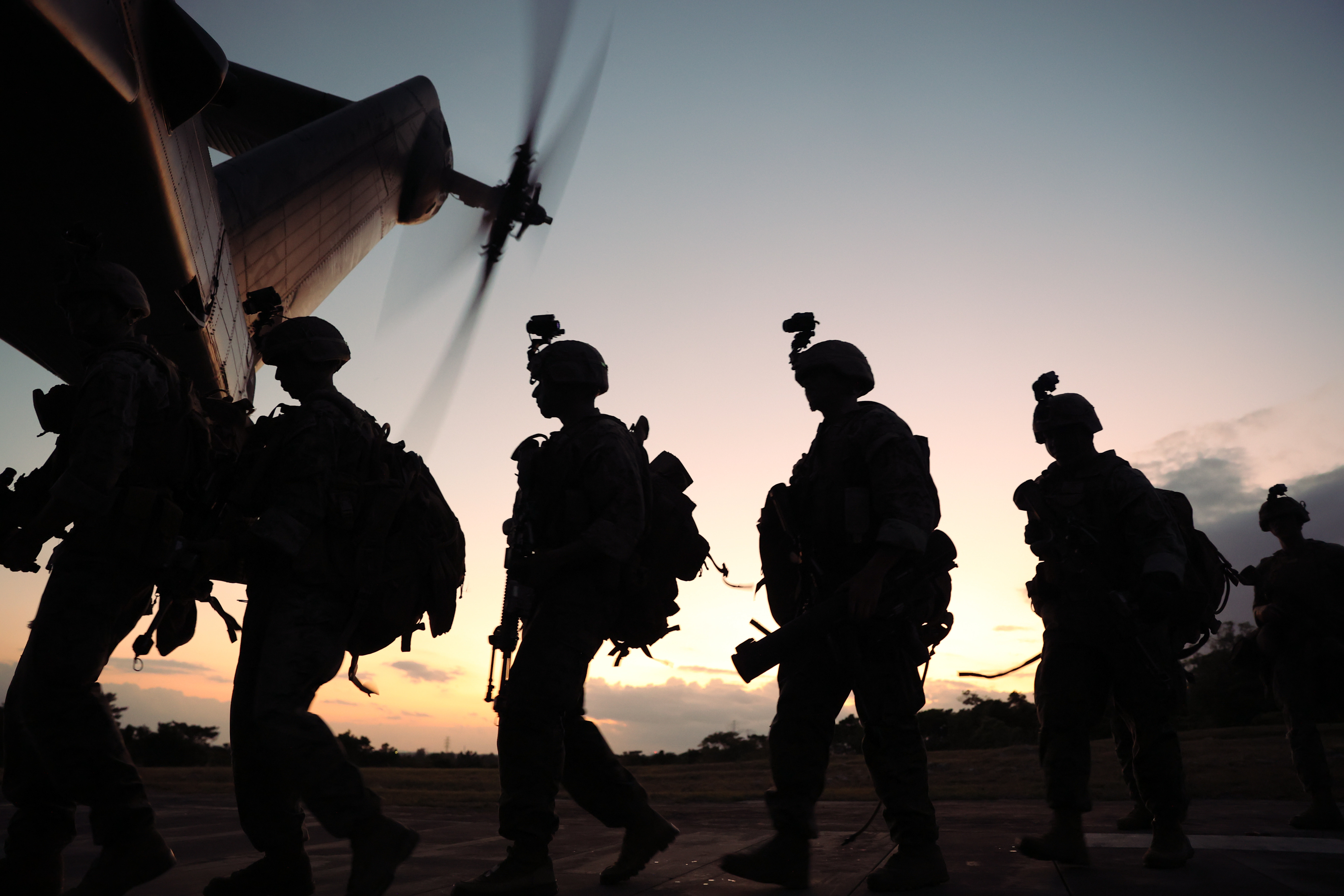

Corps leaders are fielding equipment and implementing steps toward the 2030 goals of a lighter, more flexible and technical service.

By Caitlin M. Kenney
The Marine Corps is now seven years away from 2030, the date by which Commandant Gen. David Berger intends the service to be ready for competition with near-peer adversaries like China and Russia.
His 2019 Commandant’s Planning Guidance and Force Design 2030 documents laid out a no-holds-barred approach to preparing his service for a new style of conflict. Gone are the tanks and military police units, and in their place will be more unmanned squadrons and a redesign of infantry battalions. Coming in are new ships and new organizations and expectations for units designed to operate in austere environments. What is important this year and over the next few is fielding some of the equipment and implementing changes to personnel management.
“It's time to put stuff out there,” Berger said. “Doesn't have to be the whole enchilada right now, but they got to see stuff coming their way…We have to give it to Marines now so that they can start using it.”
Among the gear he wants to arrive soon are the Navy Marine Corps Expeditionary Ship Interdiction System, or NMESIS, with the Naval Strike Missile; the CH-53K King Stallion helicopter, and the amphibious combat vehicles. He also wants to move the large MQ-9A drones the Corps operates in U.S. Central Command’s area to the Pacific.
Force Design
This year, Marines will finally learn the results of the Infantry Battalion Experiment Campaign Plan, or IBX30, which aims to reorganize the service’s infantry battalions. The Force Design document called for the experiment to test a proposal for a smaller force given extra training to hold their own in a challenging environment. Three battalions across the service are participating in the experiment, as is a team at Quantico running tabletop exercises.
After collecting and analyzing the data, “sometime this [fiscal year] we’ll know pretty much where the infantry battalion of the future ought to be,” Berger said.
He thinks they will start implementing changes to their battalion structure this year.
“We can't wait too long. But jeez, there’s so much learning happening at the same time, we all want to make sure we’re—we don't go so fast that we’d miss a great idea,” he said.
Next up will be the Expeditionary Advanced Base Operations concept, expected to be ready by next year. Berger said he’s happy with how fast Marines have figured out how to implement it even before all the gear arrives and amid the battalion restructuring.
“They aren’t waiting for that, and I don't want them to wait,” he said. “They're figuring it out. Our job: listen. Ask questions, try to take the best of what they're learning, and they're learning, and they're learning. Figure out how the institution can fit that in going forward. It’s fun.”
This new concept will be executed by Marine littoral regiments, the first of which stood up on March 3 in Hawaii. As this 3rd MLR works toward full operational capability over the next few years, it will continue to experiment with ways to do artillery, surveillance, and electronic warfare; and to establish forward bases for the joint force.
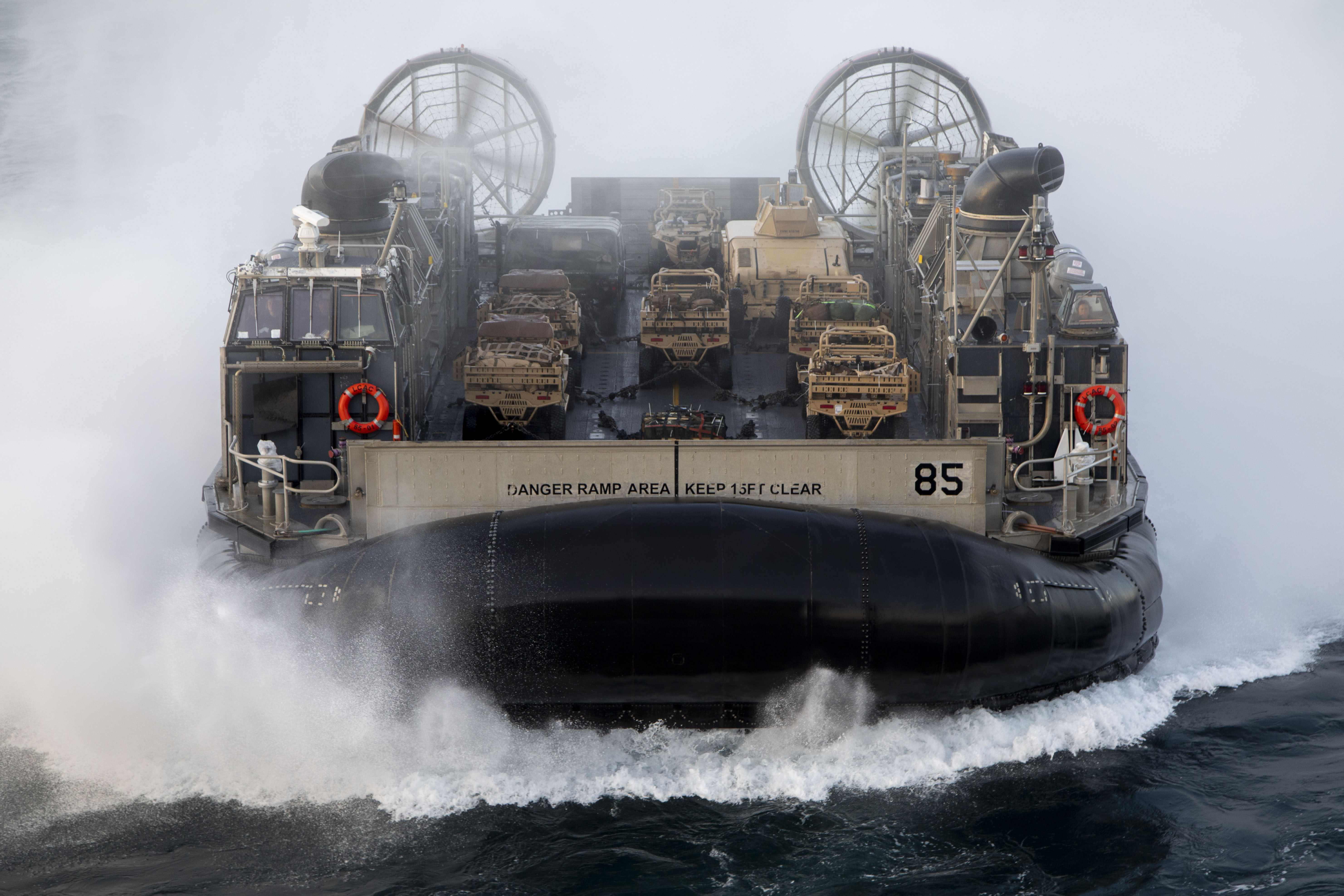
Marine Corps / Cpl. Yvonna Guyette
President Joe Biden’s National Defense Strategy is still being finalized, but Berger is confident that Force Design 2030 will support it. The team working on the new policy in the office of the defense secretary has kept the Marines apprised of roughly what’s in it, he said.
“I think when you lay out the next national defense strategy, and you put next to it force design, you'll go ‘No problems, they’re aligned’,” Berger said.
People/Talent Management
With the restructuring and concept development underway, Berger said, he is turning to the Marines’ personnel system. Released in November, his “Talent Management 2030” is part of a “fundamental redesign” intended to recruit people with needed skills and experience and retain more experienced Marines.
Part of that is updating the IT systems that manage career assignments, creating a “talent marketplace” as the Navy has done.
“We're heading in that direction so that you can see all the assignments that are open next summer. Instead of just what your assignment person needs to fill, you can see it all. And you can communicate with them all,” he said.
He also aims to diversify the force, and help Marines understand why this is critical to finding the best solutions to tough problems, through open discussions without repercussions or stigma.
“Diversity—put aside the ‘woke,’ respond to—whatever, put all that stuff aside. I know in my heart that an organization works better when it's more diverse. Every single study says that, so that's not an opinion. If that's true, then now we're not talking about a number anymore, we're actually talking about: what is the peak of warfighting capability that our unit can be, relative to the threat, what is that? I know that there's a diversity element to that,” he said.
This year, Berger wants to make sure Marines “understand the ‘why.’ Because otherwise it turns into ‘you were told to do an hour of training’.”
We can't wait too long. But jeez, there’s so much learning happening at the same time, we all want to make sure we’re—we don't go so fast that we’d miss a great idea.Marine Corps Commandant Gen. David Berger
Budget
Like their Navy brothers and sisters, the Marines remain busy in the wake of the withdrawal from Afghanistan. Maintaining readiness, training with allies, and deploying with the Navy while marching towards the future of great power competition costs money. This fiscal year has brought the additional pressures of five months without a new budget and the highest inflation in 40 years.
So the Marine Corps has been doing everything it can to find savings, in the hopes that their budget discipline will encourage Congress and the Defense Department to reward them with extra money.
“If I don't ask you for any more money, and I, from within, do everything within my power to become efficient, to make sure we're squeezing every dollar out. Then when you have a checkbook too, you're going to look around and go, ‘Who should I give extra money to?’” Berger said. “I think the logic is they’ll, not reward, but that is the incentive for good behavior in any organization, not just the military.”
Congress’ more-than-five-month delay to pass a 2022 budget delayed contracts the Marines had planned, and they have had to operate and train without knowing when they would be reimbursed. When interviewed for this story during the continuing resolution in February, Berger was not concerned that the Force Design 2030 timeline would be thrown off the rails but that it was being delayed every month without the needed investment of funds.
“We could talk about the danger of that. If it were, let's say it was seven or eight or nine years ago, we could say, ‘hmm that's really bad.’ But we're in a different place right now with peer competitors who aren’t operating in a continuing resolution. They're fully funded and moving,” he said. “So the problem is keeping in this pacing, you know, world we're in, we can't keep pace if we don't have a budget. They're moving. There's no continuing resolution in Russia or China.”
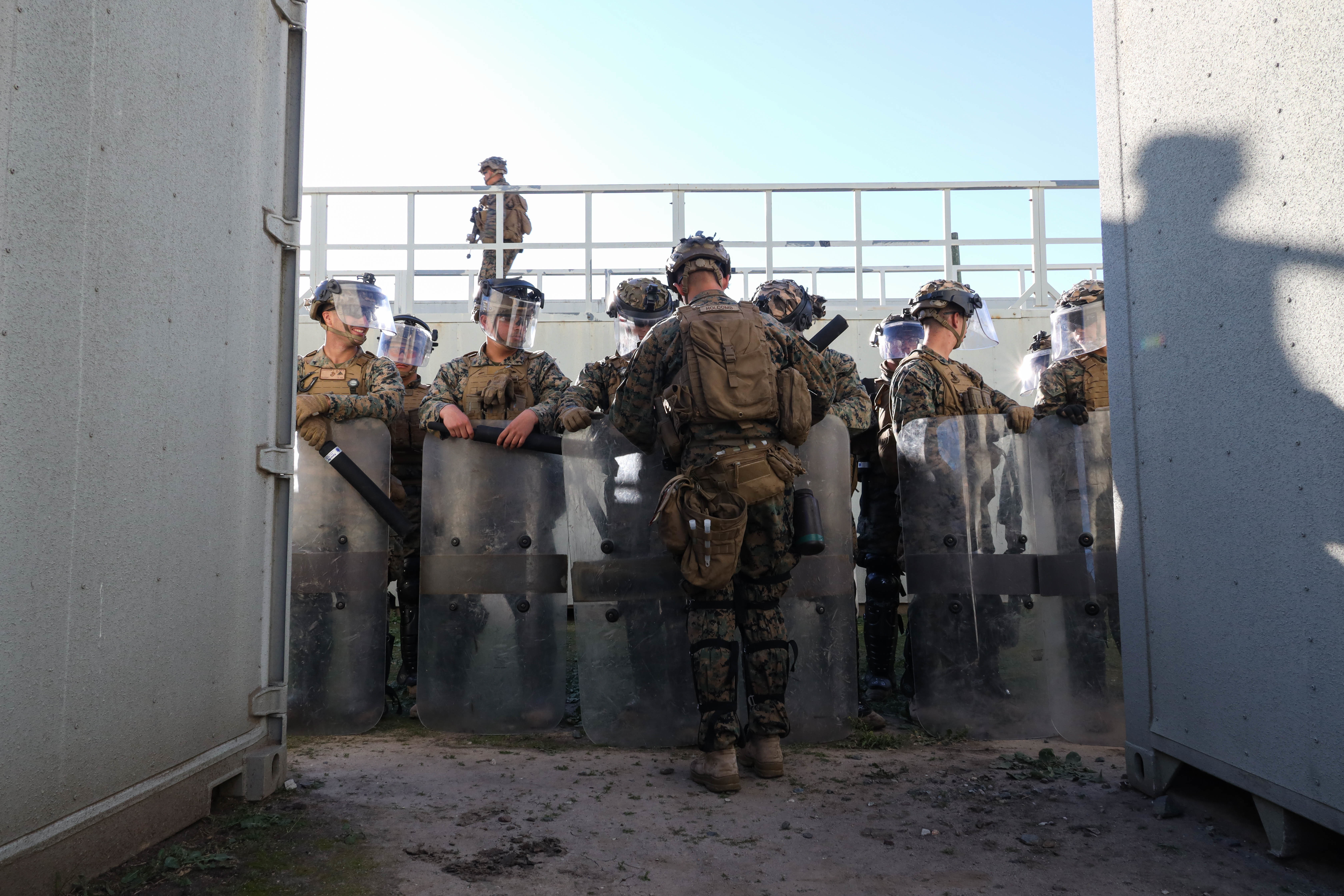
Marine Corps / Cpl. Benjamin Aulick
Deployments
Russia’s invasion of Ukraine has dominated the news and foreign policy discussions for weeks and thousands of American troops have been sent to Europe to assure allies and deter further Russian aggression, especially against nearby NATO countries. But for Marines, the Indo-Pacific region remains the primary theater. The crisis with Ukraine is not going to distract the Marine Corps, Berger said days before the invasion, because “China is the nation's most significant challenge.”
“So whatever happens in Europe doesn't change that. We have to account for that, but it doesn't change that,” he said. “We can't get pulled off of the reality of where China is in the world, that current events can't pull us off of there. But we have to be able to absolutely flex, adjust, respond.”
Berger also pointed to a recent trip by Secretary of State Antony Blinken to the Indo-Pacific during the tensions over Ukraine and how it signified that the U.S. government was capable of keeping the region a priority.
“Pretty powerful. We are the same in the Marine Corps. That's two-thirds of our operating forces, two-thirds of our fleet Marine force is assigned to Adm. [John] Aquilino and INDOPACOM. Hadn’t changed,” he said. “So our pressure, our presence, our contribution for him hasn't flickered.”


Russia’s invasion tests the new military branch, and makes a case for accelerating the Space Force’s plans for the future.

By Tara Copp
In previous wars, in order to control the land, you had to control the sky. Ukraine may become the first conflict to prove that air dominance now must reach into space, too.
“This conflict has put the entire space architecture in the forefront of combat and operations. It is the ultimate higher ground,” said Rich Cooper, vice president of outreach for the Space Foundation. “Today that ‘sky’ is 40-plus miles above the Earth.”
Space-enabled communications are an integral element of the weeks-old Ukrainian invasion and they have played a large role in upending Russian leader Vladimir Putin’s plans for a fast takeover of Ukraine.
Clear commercial satellite imagery provided real-time tracking of Russian troop movements and a bogged-down convoy with high-resolution clarity that in previous wars only the world’s top militaries and intelligence agencies could access. Ukrainian President Volodymyr Zelenskyy has mastered the information war in his daily broadcasts via social media, countering Russian propaganda and motivating his fellow Ukrainians to fight.
And when Russia tried to cut Ukraine off from the internet, commercial space played an important role again. SpaceX founder Elon Musk shifted his private Starlink satellite communications network and sent terminals to Ukraine so Ukrainians could stay connected. The connection software has become the country’s most-downloaded app.
In Washington, Russia’s invasion promises to accelerate efforts to secure U.S. space access and satellites. Congress recently added $550 million to speed development of a new military satellite program that will transfer into the U.S. Space Force later this year. And in recent weeks, others have echoed the argument that chief of space operations Gen. John Raymond has made since the Space Force was established in December 2019: Space is a war-fighting domain and the time to get ahead of that curve is now.
“Space has probably emerged in our internal reviews as the most important foundational area for everything we are doing, everything we need to be doing, whether it’s versus China, versus Russia or anybody else” Defense Department comptroller Michael McCord said earlier this month at the McAleese security conference.
That importance was also codified in Air Force Secretary Frank Kendall’s seven operational imperatives for the department. Priority one is ensuring a resilient space order of battle.

Space Force / Senior Airman Danielle McBride
Now into its third year, the Space Force has matured beyond setting up its commands and personnel structures, and is concentrating on the intelligence and battle capabilities it might need sooner rather than later. It’s also grappling with how to best integrate the flourishing commercial satellite space industry into national defense and what that might mean for the U.S. if those systems are hit.
“Every instrument of national power, diplomatic information, military, economic, is all underpinned by space,” Raymond said at the McAleese conference. “A few years ago, we could assume unfettered access to space and freedom to maneuver in space. You can't assume that anymore.”
One of the big lessons coming out of Ukraine is the need for resilience in the form of smaller, dispersed satellites in low Earth orbit. It’s a point Raymond has made repeatedly to Congress, think tanks, and reporters: that the United States currently nests critical GPS and tracking capabilities in a few large, vulnerable, and very expensive satellites. Then Elon Musk underscored that argument when his low Earth, mobile Starlink constellation ensured Russia could not put Ukraine in a blackout.
The Tranche 0 and Tranche 1 Transport Layer, a constellation of networked, low Earth orbit, optically connected satellites underway at the Space Development Agency are the military’s answer for that resiliency, and the program transfers into the Space Force this fall. They are expected to launch into service by 2024.
“If you were to ask me what's our big emphasis this year,” Raymond said in an interview with Defense One, “it's building a more resilient architecture that can more effectively operate in the strategic environment that we face.”
By forming a linked network, the satellites will be more dispersed and survivable. They’ll be able to speed NATO allies targeting data with secure Link-16 communications and track hypersonic missiles with unprecedented speed and accuracy, a senior defense official told reporters on Tuesday.
The program got an unexpected $550 million funding boost from Congress in the 2022 omnibus budget bill to speed up satellite development and launch, the official said.
The satellites will “be able to detect missile launches at sensitivity levels that are not achievable today with the missile warning system,” the official said, “and being able to provide those those rocket and missile launch and detection data to war fighters directly in theater, over tactical data links, so that they can either take evasive action, take cover or in the event that we have capabilities to take them out in glide or terminal phase, to be able to engage.”
Ukraine has made the need for this capability more urgent, the official said.
The whole point of these proliferated architectures is so that in conflicts like we see in Ukraine and could be anticipated in the future and other parts of the globe, we can fight as a unified force at great speeds that have never been demonstrated before,” the official said.
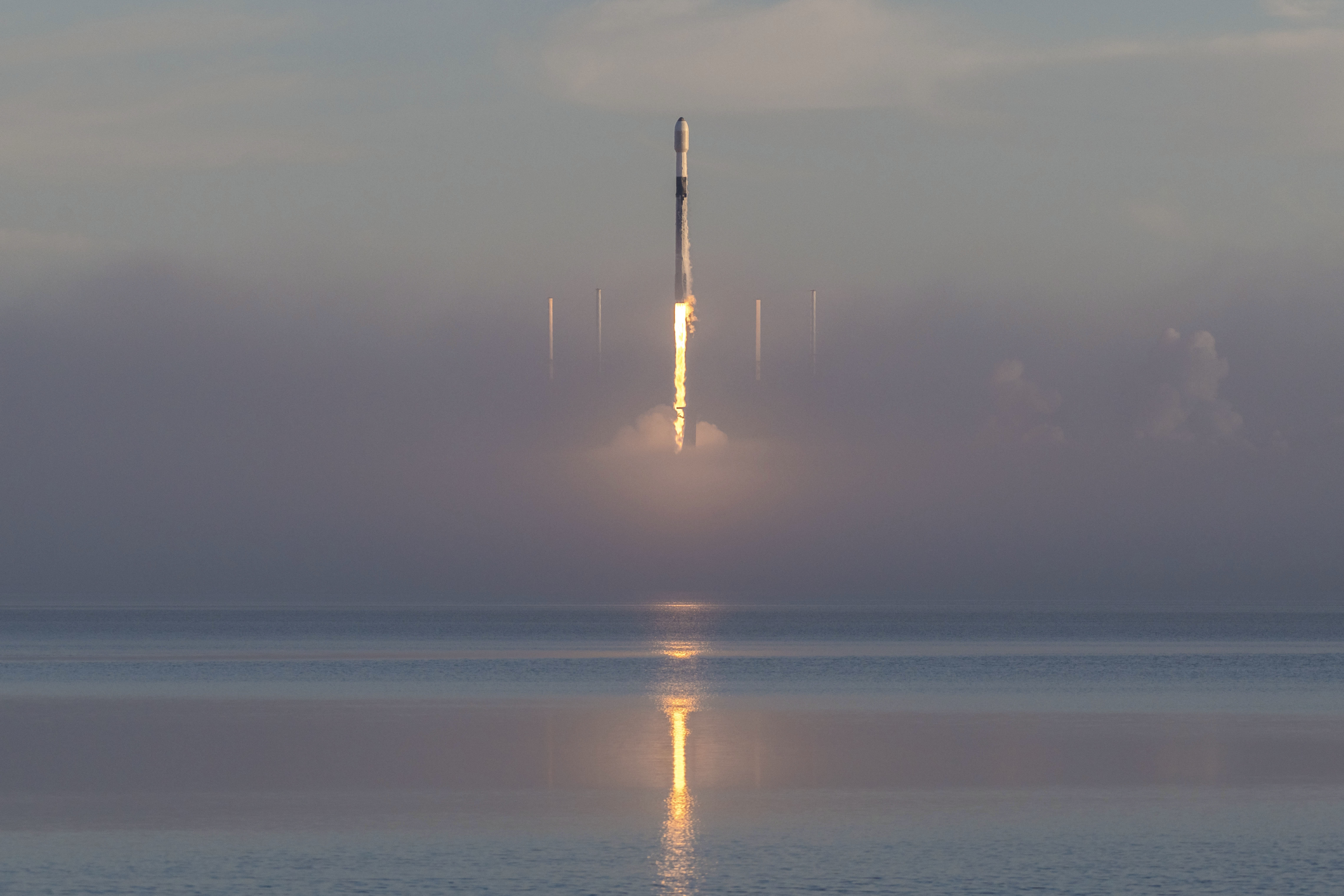
Air Force / Joshua Conti
“Recent events have shown us that these capabilities are not something that we want to delay in fielding. I think that the appropriators saw that as well, and that's why they wanted to make sure that we got these capabilities to the warfighter as rapidly as possible. And that's what led to our additional funding,” the official said.
The Ukraine conflict has also highlighted the role commercial satellite firms have in national security, and in mid-February, just as commercial satellite firms Maxar and Planet were showing the world the massive Russian buildup along Ukraine’s border, the Space Force was tasked by Air Force Secretary Frank Kendall to look at how those firms could be leveraged to augment low Earth orbit capabilities.
That raises a lot of inevitable questions, not only for this conflict, but for competition by the United States, Russia and China in future space operations too, said Victoria Samson, Washington office director for the Secure World Foundation.
“What's really interesting as well for this conflict…is kind of a blurring of the line between military and commercial space,” Samson said. ”The question is, how do you distinguish between combatants and non-combatants now?”
“It's a gray area, and I think it's going to become more and more important, and we're definitely seeing that becoming an issue as part of this conflict,” she said.
This year, the Space Force will also move forward on establishing the National Space Intelligence Center. The center will remain nested within the larger National Air and Space Intelligence Center at Wright-Patterson Air Force Base, but “sharpen the focus on space intel,” Raymond said. “This is a critical center that we need to respond to the changing nature of the domain that we find ourselves in.”
The Space Force is also expected to complete a proposal on how it could conduct the Air Force’s Ground Moving Target Indicator mission over its satellite network, to provide that capability when JSTARS aircraft cannot fly into highly contested zones.
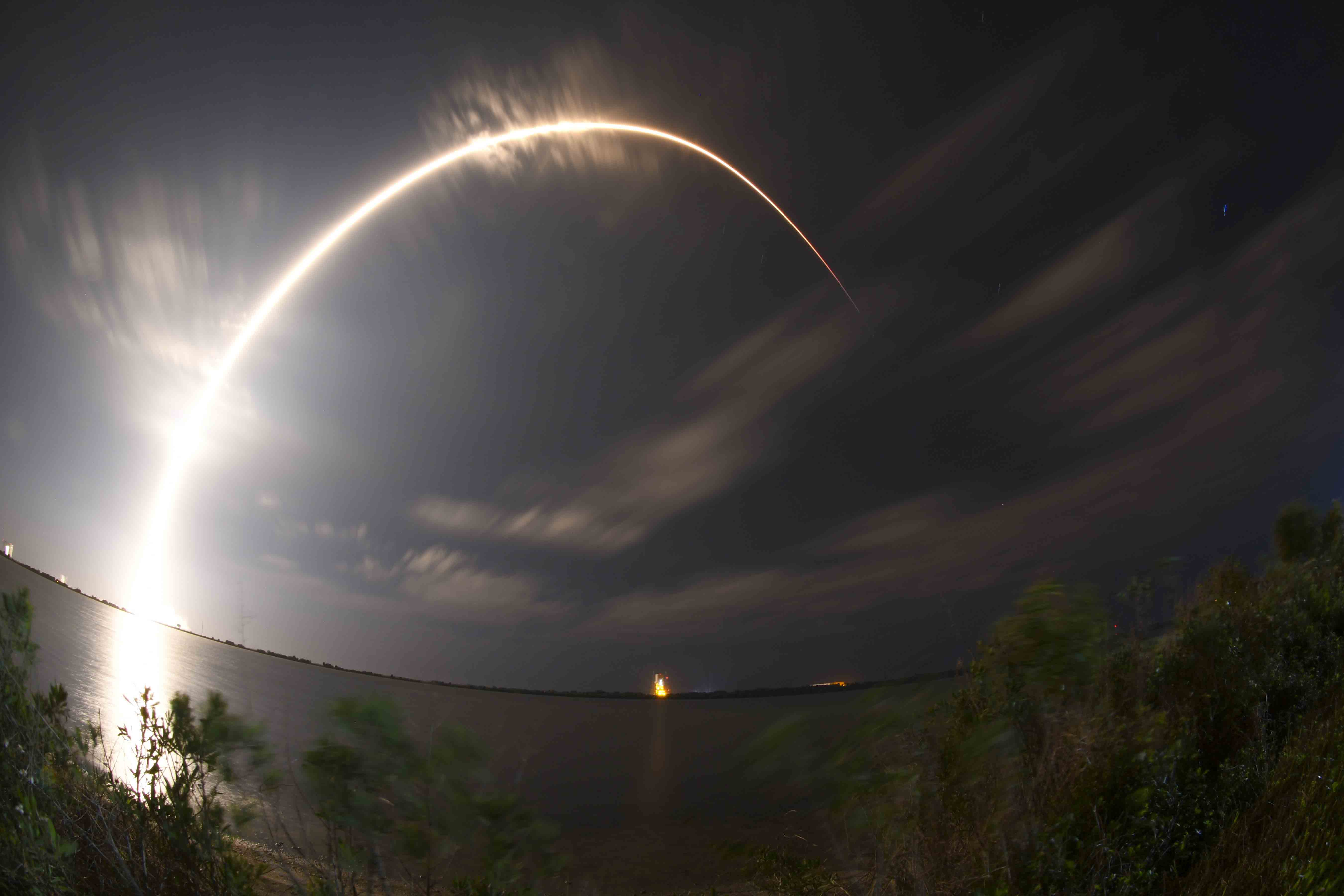
Space Force / Senior Airman Dalton Williams
“That work is ongoing; it will be done this spring here in the next couple of months,” Raymond said.
The Space Force is still working with the other military departments through the Joint Requirements Oversight Council to treat satellite-generated tactical-level ISR as a “task class” to see what each services’ requirements are, and doing the same with intelligence agencies that operate their own satellites.
“Once we get those requirements defined, we'll work with the intelligence community to figure out which ones of those requirements are being satisfied, which ones might not be satisfied, and then come up with a plan jointly between us and the Intelligence community to meet the needs that aren't being addressed,” Raymond said.
It’s much more progress than the space operations chief expected in the service’s first two years of existence as the service grew from just him to more than 14,000 Guardians and civilians.
“We're a couple of months over two years old,” Raymond said. “If you told me we made the progress that we have made by now, I wouldn’t have thought that was possible.”
“We’ve got all the pieces coming together.” 

Sponsored by:
